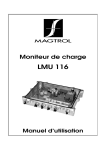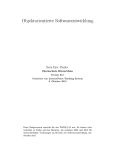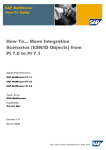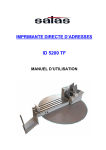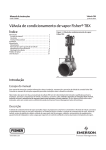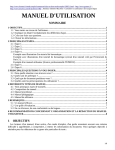Download LMU 216 - Magtrol
Transcript
Load Monitoring Unit LMU 216 User’s manual While every precaution has been exercised in the compilation of this document to ensure the accuracy of its contents, Magtrol assumes no responsibility for errors or omissions. Additionally, no liability is assumed for any damages that may result from the use of the information contained within this publication. Copyright Copyright ©2012Magtrol, Inc. All rights reserved. Copying or reproduction of all or any part of the contents of this manual without the express permission of Magtrol is strictly prohibited. First Edition, rev. D – May 2012 Revisions To This Manual The contents of this manual are subject to change without prior notice. Should revisions be necessary, updates to all Magtrol User’s Manuals can be found at Magtrol’s web site at www.magtrol.com/support/manuals.htm?tab=2#TabbedPanels1. Please compare the date of this manual with the revision date on the web site, then refer to the manual’s Table of Revisions for any changes/updates that have been made since this edition. Table of Revisions Date Edition Changes Section 05/22/2012 First Edition, rev. D adding the inversion to the amplifier adjusts the X coefficent on MEM783 card 4. Fig.4-3, Fig 4-8, appendix A 03/26/2010 First Edition, rev. C Section 4.2. Using B.I.T.E signal added. 4.2 12/09/2009 First Edition, rev. B The micro switch SWB9 «must be ON» was changed to the micro switch SWA10 «must be OFF.» 3.2 07/01/2009 First Edition, rev. A 0% hysteresis changed to < 0.5% 2.4.4.1, 2.4.4.2, 2.4.4.3, and 2.4.4.4 05 2009 First Edition - - i Table of Contents Revisions To This Manual.................................................................................................................i Table of Revisions........................................................................................................................................................i Table of Contents............................................................................................................................ii Table of Figures......................................................................................................................................................... iii Preface................................................................................................................................................ iv Purpose of This Manual......................................................................................................................................... iv Who Should Use This Manual.............................................................................................................................. iv Manual Organization............................................................................................................................................. iv Symbols used in this manual............................................................................................................................... v WARNING........................................................................................................................................................................... v 1. Introduction..................................................................................................................................1 1.1General information......................................................................................................................................... 1 1.2 Data Sheet................................................................................................................................................................. 2 2. Installation / Configuration...................................................................................................7 2.1General information......................................................................................................................................... 7 2.2 Installation of the LMU 216 load monitoring unit........................................................................... 7 2.3 Connection of the LMU 216 load monitoring unit............................................................................. 9 2.4 Configuration of the Load monitoring Unit...................................................................................... 10 2.4.1 Adaptation of the monitor to the available supply unit.................................................................................. 10 2.4.2 Selection of the type of wiring to the strain gauge......................................................................................... 13 2.4.3 Designation of the voltage and current inputs/outputs................................................................................... 13 2.4.4 Configuration of the detection chains............................................................................................................ 14 2.4.5 Selection of the pass band.............................................................................................................................. 21 2.4.6 Selection of the sensitivity range................................................................................................................... 22 2.4.7 Signal combination on the summer................................................................................................................ 22 2.4.8 Division of the transducer signal or the input voltage Ui/p by two................................................................ 24 2.4.9 Selection of the X coefficient range............................................................................................................... 24 3. Calibration...................................................................................................................................26 3.1Zero Adjustment on the voltage output Uo/p................................................................................................................... 26 3.2Zero adjustment on the current output Io/p.................................................................................................................... 27 3.3 Sensitivity adjustment on the voltage output Uo/p................................................................................................ 27 3.4 Sensitivity Adjustment on the current output Io/p................................................................................................. 27 3.5 Adjustment of the detection thresholds........................................................................................... 28 3.5.1 Adjustment of the detection threshold Ulevel1.................................................................................................................................. 29 3.5.2 Adjustment of the detection threshold Ulevel2.................................................................................................................................. 29 3.5.3 Adjustment of the detection threshold Ulevel3.................................................................................................................................. 30 3.5.4 Adjustment of the detection threshold Ulevel4.................................................................................................................................. 30 3.6 ADjustment of the summer coefficient X............................................................................................ 31 3.7 Taring circuit Configuration..................................................................................................................... 32 3.7.1 Enter a TARE................................................................................................................................................. 32 3.7.2 Remove the TARE.......................................................................................................................................... 32 3.7.3 TARE signal selection.................................................................................................................................... 32 3.7.4 Taring control circuit connection diagram..................................................................................................... 33 3.8 Calibration of the built-in test equipment (B.I.T.E.)........................................................................ 34 ii Magtrol Load Monitoring Unit LMU 216 Table of Contents 4. Applications.................................................................................................................................35 4.1 Using one or several load monitoring units.................................................................................... 35 4.1.1 Simple weighing for cranes with Tare adjustment......................................................................................... 35 4.1.2 Multi-transducer weighing for container gantry cranes................................................................................. 39 4.2 Using B.I.T.E. signal............................................................................................................................................. 41 5. Repair...............................................................................................................................................45 5.1 Trouble-shooting.............................................................................................................................................. 45 Appendix A : Configuration and calibration report......................................................................................... 46 Appendix B : CE Conformity declaration..............................................................................49 Magtrol Limited Warranty..........................................................................................................50 Claims.............................................................................................................................................................................. 50 Service Information.......................................................................................................................51 Table of Figures 2. Installation / Configuration Fig. 2–1 Installation of the LMU 216 load monitoring unit...............................................................................................8 Fig. 2–2 Stuffing gland (overall and exploded view)..........................................................................................................9 Fig. 2–3 Load monitoring unit board with location of the selection elements.................................................................10 Fig. 2–4 Jumper and switch configuration........................................................................................................................11 Fig. 2–5 LMU grounding when using a 230, 115 or 48 VAC supply................................................................................12 Fig. 2–6 Types of wiring....................................................................................................................................................13 Fig. 2–7 Location of the SWA micro-switches..................................................................................................................14 Fig. 2–8 Location of the SWE micro-switches..................................................................................................................17 Fig. 2–9 Examples of switching delays.............................................................................................................................19 Fig. 2–10 Potentiometer location on the load monitoring unit board (P1 to P10)...........................................................20 Fig. 2–11 Potentiometer location on the load monitoring unit board (P12 to P15).........................................................20 Fig. 2–12 Location of the SWB micro-switches on the load monitoring unit board.........................................................21 Fig. 2–13 Location of the SWD micro-switches................................................................................................................23 3. Calibration Fig. 3–1 Fig. 3–2 Fig. 3–3 Fig. 3–4 Fig. 3–5 Fig. 3–6 Fig. 3–7 Location of the potentiometers on the load monitoring unit board....................................................................26 Location of the micro-switches SWC on the load monitoring unit board...........................................................28 Location of the relays REL1 and REL2 and of the micro-switches SWB of the load monitoring unit board................. 29 Location of the relays REL3 and REL4 and of the adjustment potentiometers.............................................................. 30 Location of the X coefficient adjustment components........................................................................................31 Internal connection taring circuit diagram........................................................................................................33 External connection taring circuit diagram.......................................................................................................33 4. Applications Fig. 4–1 Fig. 4–2 Fig. 4–3 Fig. 4–4 Fig. 4–5 Fig. 4–6 Fig. 4–7 Fig. 4–8 Fig. 4–9 Simple weighing application..............................................................................................................................35 Simple weighing system......................................................................................................................................36 Configuration and calibration protocol for a simple weighing application (part 1 of 2)..................................37 Configuration and calibration protocol for a simple weighing application (part 1 of 2)..................................38 Multi-transducer weighing application..............................................................................................................39 Multi-transducer weighing system......................................................................................................................40 B.I.T.E. control input terminals..........................................................................................................................42 Configuration and calibration protocol for a multi-transducer weighing system (part 1 of 2).........................43 Configuration and calibration protocol for a multi-transducer weighing system (part 2 of 2).........................44 iii Preface Purpose of This Manual This manual has all the necessary information regarding the installation, connection, calibration and use of Magtrol's LMU 216 load monitoring unit. To achieve maximum capability and ensure proper use of the system, please read this manual in its entirety before operating. Keep the manual in a safe place for quick reference whenever a question should arise. Who Should Use This Manual This manual is for users who want to install and use the load monitoring unit LMU 216 for processing data generated by load measuring pins. The user should have suitable technical training in mechanics and electronics so as to allow him to install and use this load monitoring unit without risk. Manual Organization This section gives an overview of the structure of the manual and the information contained in it. Some information has been deliberately repeated in different sections of the document to minimize cross-referencing and to facilitate understanding through reiteration. Summary of the different chapters : Chapter 1 : Introduction – Contains the technical data sheet of the load monitoring units LMU 216 and gives its technical characteristics as well as a brief overview of the application fields. Chapter 2 : Installation / Configuration – Contains the mounting and configuration explanations for the load monitoring unit LMU 216. Chapter 3 : Calibration – Describes the calibration procedures of the zero, sensitivity and relays detection level of the load monitoring unit LMU 216. Chapter 4 : Applications – Describes two examples of applications for one load monitoring unit LMU 216. In the first example only one transducer is used, in the second four of them are used. Chapter 5 : REPAIR – Contains solutions to problems encountered with LMU series load monitoring units. Appendix A : CONFIGURATION AND CALIBRATION REPORT – Contains the configuration and calibration report of the LMU 216 which must be filled in with great care when installing the load monitoring unit. Appendix B : CE CONFORMITY DECLARATION – Contains the CE conformity declaration of the MAGTROL LMU series load monitoring units. iv Preface Magtrol Load Monitoring Unit LMU 216 WARNING WARNING The lightning inside of a triangle indicates the presence of dangerous non insulated components in the apparatus which may expose the user to electric shocks. ELECTRIC SHOCK HAZARD WARNING : THE INSTALLATION AND CALIBRATION OF THE LMU UNIT MUST BE CARRIED OUT BY SUITABLY QUALIFIED AND TRAINED PERSONNEL. PLEASE READ THIS MANUAL BEFORE INSTALLING AND CALIBRATING THIS LMU UNIT AND FOLLOW CLOSELY THE OPERATING INSTRUCTIONS. THE WIRING MUST ONLY BE CARRIED OUT WHEN THE MAINS ARE SWITCHED OFF. THE CALIBRATION ASKS TO OBSERVE THE RELEVANT SAFETY WORKING METHODS. The exclamation mark inside of a triangle is used to inform the user, that some important instructions about how to operate and maintain the apparatus are to be found in the manual delivered with the unit. PLEASE PAY ATTENTION TO THE SYMBOLS PLACED ON THE LOAD MONITORING UNIT. Symbols used in this manual The following symbols and type styles may be used in this manual to highlight certain parts of the text: Note: Caution: This is intended to draw the operator’s attention to complementary information or advice relating to the subject being treated. It introduces information enabling the correct and optimal function of the product. This is used to draw the operator’s attention to information , directives , procedures , etc . which , if ignored , may result in damage to the material being used . T he associated text describes the necessary precautions to take and the consequences that may arise if these precautions are ignored. WARNING! This introduces directives, procedures, precautionary measures, etc. which must be executed or followed with the utmost care and attention, otherwise the personal safety of the operator or a third party may be at risk. The reader must absolutely take note of the accompanying text, and act upon it , before proceeding further. v 1. Introduction 1.1 General information The LMU series load monitoring units have been specially designed for applications using load pins with strain gauge sensors. This range of monitoring units offer a large degree of flexibility for the implementation of load measuring systems. Three models of load monitoring units are available : •LMU 212 : basic model •LMU 217 : model combining two LMU 212 placed side by side •LMU 216 : model combining one LMU 212 and a control module. Note :Only the model LMU 216 will be described in this manual. The LMU 212 and LMU 217 are the subject of one manual entirely dedicated to them. The specially robust design of these units allows monitoring load limits in the most challenging environments. 1 Chapter 1 – Introduction 1.2 Magtrol Load Monitoring Unit LMU 216 Data Sheet M AGTROL LMU Data Sheet LMU Series Load Monitoring Units Features • Forusewithfull-bridgestraingaugetransducers (sensitivity0.5to4mV/V) • Voltageinputforloadsummationorforindividualuse (withoutsensor) • 2to4leveldetectorswithrelayoutputcontacts • 0–20mAor4–20mADCcurrentoutput • ±10Vvoltageoutput(s) • Providescontinuousdetectionofsignallinefailureand shortcircuits(«OK»signals) • Includesintegratedtestequipment(B.I.T.E.)with continuouspowersupplymonitoring • CompatibletoCEStandards • IP65aluminumhousing Features of LMU 216 only: • 4leveldetectorswithoutputcontacts,2ofthemwith programmablememory • Summerwith4inputs • Tarefunction • Optionalbalancingandcomparatorsub-module Description TheMagtrolLoadMonitoringUnitisspeciallydesignedfor straingaugetransducerapplications.Specificallydeveloped for use with Magtrol load measuring pins and load-forceweightsensors,theLMUSeriesprovidesexcitationcurrent andamplifiestheoutputsignaloffull-bridgestraingauges. LoadMonitoringUnitsareflexibleandfullyconfigurable due to DIP-switches and jumpers which allow the unit to beeasilyinstalled—nosolderconnectionsarerequired.The leveldetectorsandtheoutputscanbededicatedeithertothe LMU 217 LMU 212 LMU 216 full-bridgeinput,tothevoltageinput,ortothesumofboth (see “Application Selection” at the top of page 3).Abuilt-in auto-diagnosticsystemdetectsanyshortcircuitsorsignalline failures,thus allowing the system to be used in applications where safety is important.Ifaproblemisdetected,both relays are deactivated and the output voltage (respective current)changesto>10VDCand>20mA. TheLMUisfullycompatiblewithEuropeanCommunity(CE) standards.ItsIP65aluminumhousingallowsthesystemto beusedinharshenvironments.UsingSMD(surfacemounted device)technology,theLMUallowsthemaximumperformance/ priceratioforstraingaugetransducermonitoring. MoDel coMparison Description Voltage Output Current Output Relays Summation LMU 212 LMU 217 LMU 216 1 transducer input 1 × 0–10 V 1 × 0–20 mA or 4–20 mA 2 2 signals 2 transducer inputs (2 × LMU 212) 2 × 0–10 V 2 × 0–20 mA or 4–20 mA 4 3 signals 1 transducer input 3 × 0–10 V 1 × 0–20 mA or 4–20 mA 4 4 signals www.magtrol.com 1 2 Magtrol Load Monitoring Unit LMU 216 Chapter 1 – Introduction Specifications LMU INPUT CHARACTERISTICS Power Supply • 115–230 VAC and 20–32 VDC Voltage jumper selectable • 48 VAC fixed Fuse rating Current 70 mA for 230 VAC 80 mAT 150 mA for 115 VAC 160 mAT Maximum Current 250 mA for 20 VDC 400 mAT 350 mA for 48 VAC 400 mAT Bridge signal Supply Voltage 10 VDC Max. Possible Current 140 mA DC Sensitivity 0.5 to 4 mV/V Max. Dynamic Component of Bridge ±45 mVDC Signal Max. Common Mode ±10 V Voltage on Input Voltage Input for Summation of Another Load Input Impedance 70 kΩ Max. Input Signal ±10 V (dynamic) Signal Division by 2 DIP-switch selectable Use Without Transducer Jumper selectable Input for Auto-diagnostic Feature (OK I/P) Type Active if short circuited OUTPUT CHARACTERISTICS Relay Outputs LMU 212: 2 Number of Relays LMU 217: 4 (2 per input) LMU 216: 4 Relay Behavior Configurable with DIP-switch 4 A at 250 V AC Max. Current per Contact 3 A at 30 V (0,5 A at 48 V DC) Max. Voltage per AC : 250 Veff DC : 48 VDC Contact Contact Rating 90 W or 1000 VA Contact-contact: 750 Veff Insulation Voltage Contact-coil: 1.5 kVeff min. 105 (at 4 A, 250 V AC) Lifetime 108 (unloaded) Contact Resistance < 20 mΩ Current Output Output Type Current generator Nominal Current Range 0 to 20 mA DC Max. Current Range 0 to 25 mA DC Max. Load < 500 Ω for Imax = 20 mA Output Impedance > 50 kΩ Voltage Output Max. Dynamics ±10 V ≡ EM Max. Load ≥10 kΩ (ε≤0.5%) [≥1 kΩ (ε≤5%)] * Output Impedance 50 Ω (in series) Output for Auto-diagnostic Feature (OK O/P) Type Open collector TRANSFER CHARACTERISTICS Voltage Transfer Ranges (∆UI/P / ∆UO/P) Range 1 2 3 Bridge Sensitivity 0.42 to 0.78 0.7 to 1.3 1.2 to 2.2 [mV/V] (0.6) (1) (1.7) Voltage Transfer 2380 to 1280 1428 to 769 833 to 455 (gain) (1670) (1000) (588) Adjustment Range ±30% ±30% ±30% Range Selection Signal Division by 2 Measuring Chain Zero Adjustment Selectable using DIP-switches DIP-switch selectable (the available sensitivities then moves from 0.84 to 4.4 mV/V according to the selected range) Coarse adjustment using multiturn potentiometer: equivalent to ±10 V/output for range 3 Fine adjustment using multiturn potentiometer: 5% of the coarse adjustment Temperature drift of the ≤ 200 ppm/°C transfer function Temperature drift of the ≤ 200 ppm of FSD/°C for measuring chain zero 0.5 mV/V at the input ≡ ≤1 value µV/°C Current transfer range Sensitivity Range with ± 20% of FSD on UO/P Multi-turn Potentiometer Nominal Current Range 0 to 20 mA DC Max. Current Range 0 to 25 mA DC Zero Adjustment Range ± 5 mA DC for IO/P ≥ 5 mA DC Selectable low-pass filter Filter Type Butterworth Filter Order 2 Selectable using DIP-switches -3 dB Cut-off Frequency (0.3 Hz, 1 Hz, 3 Hz, 10 Hz, 100 Hz) Level detectors Number of Detectors 1 per relay Level Adjustment Range Hysteresis Detection Indication Switching Delay -10 to +10 VDC using multi-turn potentiometer (measured on voltage output) <0.5% or ≈ 5% (DIP-switch selectable) < or > (DIP-switch selectable) 0.01 to 4.25 seconds Delay Adjustment Range (adjustment for every relay by multi-turn potentiometer) * NOTE: To guarantee precise calibration, the impedance of the connected unit must be indicated at time of order. If this value is unknown, an impedance of 1 MΩ will be used for calibration. The resulting deviation will be ≤5% with an impedance of ≥2 kΩ or ≤1% with ≥10 kΩ. M AGTROL 2 3 Chapter 1 – Introduction Magtrol Load Monitoring Unit LMU 216 Specifications LMU TRANSFER CHARACTERISTICS (cont.) Application selection ENVIRONMENTAL CHARACTERISTICS Operating Temperature -40° C to +80° C Storage Temperature -45° C to +85° C Protection Class IP 65 Vibration and Shock According to IEC 68.2 According to EN 61326-1 EMC and EN 61326-2-3 SAFETY CHARACTERISTICS B.I.T.E. test signal (Built In Test Equipment) Load simulation on request Signal type (calibrated during the installation) Logic signal, active low, CMOS/ Control TTL compatible Reliability MTBF > 1,500,000 hours Output specific application: REL1 det. REL2 det. UO/P I O/P A, B or A+B A, B or A+B A, B or A+B A, B or A+B A = bride signal; B = voltage input MECHANICAL CHARACTERISTICS Housing Material Aluminum Stuffing glands LMU 212: 3 × PG 11 Type and number LMU 216 and 217: 6 × PG 11 Material Nickel-plated brass Terminal strip MK8 (screw and connection at Type 45°) AWG 20 to 16 Max. Area of Cross section: 0.5 to 1.5 mm² Connecting Wire (0.00077 to 0.0023 in²) aDDitional lMu 216 Functions SUMMER Number of Inputs Input Voltage Output Voltage LATCHING Control Reset Signal CALIBRATION CIRCUIT Volatile* digital memory at 12 bits (memory reset at startup), the stored digital value is substracted from the input signal after D/A conversion Principle 4 (UA, UB, UC and UD) ±10 V UE1 = (UA + UB ± UC ± UD)X X adjustable between 0.25 and 10 * Current interruptions lasting for less than 30 ms do not lead to the loss of the stored calibration value Using DIP-switches RESET REL3, RESET REL4 Resolution Storing Time Output Impedence Acceptable Load Resistance 1/4096 of the selected range <2s < 200 Ω ≤ 20 kΩ Basic conFiguration TheLMULoadMonitoringUnitoffersunlimitedconfigurationpossibilities.Itisimpossibletolistthemallinthisdatasheet. PleasecontactMagtroloroneofitssubsidiariesorsalesagentstodiscussyourspecificapplications. Strain Gauge Transducer Voltage Input ±10 V "OK" Input (OK I/P) Power Supply • 115–230 VAC (50/60 Hz) • 20–32 VDC • 48 VAC Relay Output Contacts • LMU 212/117: 2 per channel (RE1, RE2) • LMU 216: 4 (RE1, RE2, RE3, RE4) LMU Load Monitoring Unit "OK" Output (OK O/P) Current Output 0–20 mA or 4–20 mA Voltage Output(s) ±10 V • LMU 212: 1 • LMU 216: 3 • LMU 217: 2 LMU 216 only: Summer with 4 Voltage Inputs (±10 V) M AGTROL 3 4 Chapter 1 – Introduction Magtrol Load Monitoring Unit LMU 216 Dimensions LMU lMu 212 Mounting screw M6x30 A B L K Sealed diecast aluminum box A B C D E G J K L M N E C D J G Stuffing glands Ø cable: 5 to 12 mm M N OVERHEAD VIEW mm 122 82 220 204 ≈16 20.75 13.4 90 ≈1.5 28 47 Model Weight LMU 212 2 kg SIDE VIEW J M K lMu 216 anD lMu 217 N N P P P N SIDE VIEW N Mounting screw M6x30 H FRONT VIEW C D Stuffing glands (max. PG 11) Ø cables : 5 to 12 mm E F Sealed diecast aluminum box A B C D E F H J K M N P mm 287 272 190 175 ≈18 ≈220 12 10 90 27 30 35 Model Weight LMU 216 4 kg LMU 217 3.750 kg B A OVERHEAD VIEW M AGTROL 4 5 Chapter 1 – Introduction Magtrol Load Monitoring Unit LMU 216 Ordering Information LMU orDering inForMation LOAD MONITORING UNIT P/N 224 - -000- Model • LMU 212 (1 input) 212 • LMU 216 (1 input) 216 • LMU 217 (2 inputs) 217 Supply • 115–230 VAC (50/60 Hz) or 20–32 VDC 0 • 48 VAC (50/60 Hz) 4 Balancing comparator option (only for LMU 216) LMU 216: • No 11 • Yes 61 LMU 212: • No (not available) 11 LMU 217: • No (not available) 11 Configurated and calibrated? • No (standard) (blank) • Yes (according to application and Magtrol Configuration and Calibration Protocol) C Due to the continual development of our products, we reserve the right to modify specifications without forewarning. Magtrol inc 70 Gardenville Parkway Buffalo, New York 14224 USA Phone: +1 716 668 5555 Fax: +1 716 668 8705 E-mail: [email protected] Magtrol sa Centre technologique Montena 1728 Rossens / Fribourg, Switzerland Phone: +41 (0)26 407 3000 Fax: +41 (0)26 407 3001 E-mail: [email protected] 6 Subsidiaries in: Great Britain Germany • France China • India Worldwide Network of Sales Agents LMU-US 04/10 www.magtrol.com 2. Installation / Configuration 2.1 General information It is essential to follow and apply the installation and configuration procedure described in this chapter to avoid any perturbation of the measuring signal processed by an incorrectly installed LMU 216. Note : 2.2 The procedures described in this chapter do not cover all mounting and connection possibilities. However, they can be used as a guide for further customer specific applications. In case of doubt, the user should not hesitate to contact Magtrol's customer service to find a solution offering the best guaranty for optimal measuring accuracy. Installation of the LMU 216 load monitoring unit Note : For optimal operation, the load monitoring unit should be run at temperatures between -40° C and +80° C. Proceed as described in the following points to mount and connect a LMU 216 : 1. Select a suitable mounting place free of vibrations. An instrument support, for instance, offers excellent results. 2. Trace the location of the 4 screw taps on the mounting surface. 3. Drill and tap the 4 holes for the M6 mounting screws. The taps' depth must be approximately 15 mm. 4. Remove the cover of the load monitoring housing. The LMU 216 cover is fixed with 6 screws (see figure 2-1). 5. Position the housing on the mounting surface and fasten the 4 M6 x 30 mounting screws by applying a fastening torque corresponding to the type of screw used. 6. Configure and calibrate the load monitoring unit if not already done according to the procedure described in this chapter. 7. Carry out the necessary electrical connection and make sure that the housing stuffing glands are water-tight. 8. Insert a copy of the calibration protocol (see Appendix A) into the load monitoring unit housing before placing the cover back onto the housing and fastening its screws. 7 Chapter 2 – Installation / Configuration Magtrol Load Monitoring Unit LMU 216 Load monitoring unit cover Cover fixing screw Housing M6 x 30 fixing screw Load monitoring unit housing M6 washer Tap on the mounting surface 272 175 Fig. 2–1 Installation of the LMU 216 load monitoring unit 8 Chapter 2 – Installation / Configuration Magtrol Load Monitoring Unit LMU 216 2.3 Connection of the LMU 216 load monitoring unit The LMU 216 load monitoring unit is fitted with stuffing glands maintaining the connection cables and securing the tightness of the unit's housing. To pass the cables through the stuffing glands simply apply the following procedure : 1. Uninsulate the conductors of the different cables. 2. Remove the housing cover after having unscrewed the fixing screws. 3. Pass the cables through the stuffing glands as shown on figure 2–2 : a. Unscrew the hex nut by rotating it counterclockwise. The main body of the stuffing gland should not be removed from the unit's housing. b. Extract the internal and external gasket from the hex nut . Both gaskets are used to compensate for the different cable diameters. Push the internal gasket to extract it from the external gasket . c. Pass the cable through the hex nut , the internal gasket (when used), the external gasket , the sealing ring and the main body . d. Reassemble the stuffing gland and coat the front part of the external gasket with silicone (see figure 2–3) before screwing the hex nut onto the main body . Tighten the hex nut in such a way that the internal gasket and/or the external gasket protrudes, so as to provide the degree of watertightness required. e. Ensure also that the cable is held firmly in the stuffing gland. Caution : Do not damage the gaskets with cutting objects. Check that no foreign bodies have slid between the elements of the stuffing gland. Degrease the surface of the cable which will come into contact with the gasket. The seal of the stuffing gland cannot be guarantied if these instructions are not followed. Assembled stuffing gland Protruding gasket Cable Internal gasket Sealing ring Hex nut External gasket Only grease the front part Main body Fig. 2–2 Stuffing gland (overall and exploded view) 4. Connect the conductors of the various cables to the load monitoring unit terminals. 5. Put the cover back on the load monitoring unit and tighten up its six screws. 9 Chapter 2 – Installation / Configuration 2.4 Magtrol Load Monitoring Unit LMU 216 Configuration of the Load monitoring Unit Note : The asterisks (¶) correspond to the standard configuration of the LMU 216 version 02X, that is to say the basic uncalibrated modules. The configuration of the LMU 216 load monitoring unit includes all start-up operations which are necessary to achieve a trouble free operation. This ranges from the supply voltage to the selection of the application, the sensor connection, the energising mode of the relays and their delay time, the selection of the pass-band and the sensor sensitivity and the use of the summer. As a reminder: the LMU 216 is composed of one LMU 212 and a control module. 2.4.1 Adaptation of the monitor to the available supply unit 2.4.1.1 Supply voltage Before connecting the LMU 216 load monitoring unit, select its operating voltage by correctly positioning the jumper (DC or AC voltage) and then, in case of an AC supply, choosing the correct voltage by means of the switch. Finally choose the supply fuse rating. Warning! The monitoring unit can be seriously damaged if not destroyed, if this advice is not followed. The information given in figures 2–3 to 2–5 and in the table on the next page allows the user to select the operating voltage of the load monitoring unit, to choose the supply fuse and to assign the supply terminals. Terminal 11. .. . .. .. .. .. . .. . . .. 23 24 .. .. .. . . . .. . . .. .. 21 22 .. . . . .. . . .. .. Operating voltage selection jumper and switch .. .. . .. . . 220 0 Supply fuse Fig. 2–3 Load monitoring unit board with location of the selection elements 10 Chapter 2 – Installation / Configuration Magtrol Load Monitoring Unit LMU 216 1. Place the jumper according to the selected supply mode (see figure 2–4) : - 'DC' for a DC type supply with a voltage between 20 and 32 VDC - 'AC' for an AC type supply (230 VAC, 115 VAC or 48 VAC) 2. In case of an AC supply position the switch on (see figure 2–4) : - '230 V' for an AC voltage of 230 VAC - '115 V' for an AC voltage of 115 VAC for operating voltages of 48 VAC or 20 to 32 VDC the position of the switch is irrelevant. Operating voltage 230 VAC Operating voltage 115 VAC $& 92/7$*( $& 92/7$*( '& '& 9 Operating voltage 48 VAC Operating voltage 20 to 32 VDC '& '& $& $& 9 $& $& Fig. 2–4 Jumper and switch configuration 3. Check the rating of the fuse inserted in its support according to the following table: ¶ Supply terminals Operating voltage 0 V (18) N (19) P (20) 230 VAC earth neutral 115 VAC earth 48 VAC 20-32 VDC Fuse Switch phase 80 mAT 230 V neutral phase 160 mAT 115 V earth neutral phase 400 mAT irrelevant 0V — 20-32 V 400 mAT irrelevant A fuse of each rating is supplied with each load monitoring unit. WARNING! SWITCH OFF THE SUPPLY BEFORE WIRING THE LMU. For safety reasons it is important to secure the stability of the supply unit used and respect the operating voltage selected on the lmu. 11 Chapter 2 – Installation / Configuration Note : Magtrol Load Monitoring Unit LMU 216 Do not forget to report the designation of the collected external signals connected to the supply terminal on the configuration and calibration form (see Appendix A). Also check off the sticker placed inside of the cover to specify the voltage to which the unit is configured. Refer to user manual for adaptation to the supply voltage Operating voltage : 230 VAC / 80mA 115 VAC / 160mA 48 VAC / 400mA 20-32 VDC / 400mA Risk of electric shock! Do not handle the terminal, the fuse and/or the AC/DC selector when the unit is powered up! C B A THE INFORMATION DISCLOSED HEREIN WAS ORIGINATED BY AND IS THE PROPERTY OF MAGTROL SA. MAGTROL SA RESERVES ALL PATENT PROPRIETARY, DESIGN, USE, SALE, MANUFACTURING AND REPRODUCTION RIGHTS THERETO. 4. When using a 230 VAC, 115 VAC or 48 VAC supply always connect the LMU to the ground as shown on figure 2–5 : 1 2 Fig. 2–5 LMU grounding when using a 230, 115 or 48 VAC supply 6 5 4 3 2 1 C.S. N.B. 03.12.01 01062 C.S. N.B. 02.07.97 97133 C.B. N.B. Rev. Date PM Drawn Appr. Connect the earth wire to the ground screw and the LMU terminal no. 18 to the ground screw. 3 Warning! 12.12.02 Tolerances: ± 02076 mm to 50mm, ± Pos.17 removed ! Pos.5 and 6 changed; pos. 9 removed ! Pos. 18 added Repl. by : Repl. for: mm over 50mm Material: When using a 48 / 115 / 230 VAC supply always Finish: make sure that the LMU housing is adequately LOAD MONITORING UNIT connected to the ground! LMU 112 A B 12 C Scale 1:5 DRAWING N° LMU Chapter 2 – Installation / Configuration Magtrol Load Monitoring Unit LMU 216 2.4.2 Selection of the type of wiring to the strain gauge The choice of the type of wiring depends on the length of the cable between the LMU and the strain gauge transducer, on the impedance of the transducer and the linear resistance of the cable. If the linear resistance of the cable is ≤0,1 W/m, the impedance of the strain gauge transducer is ≥200 W and the length of the cable is ≤100 m, the wiring of type 1 can be selected (see figure 2–6). The wiring of the type 2 of figure 2–6 applies to cable lengths of more then 100 m or when the cable length has been changed after the calibration of the load monitoring unit. Strain gauge transducer 16 Supply + Strain gauge transducer 21 Supply + SENSE + 16 13 Signal + 13 Signal + 12 Signal - 12 Signal - 17 Supply - 22 Wiring type 1 17 SENSE Supply - Wiring type 2 Fig. 2–6 Types of wiring For applications in conformity with the TÜV standard detecting short-circuits and/or failure of a conductor in the connecting cable is compulsory. In this case no signal must be sent on terminals 21 (SENSE+) and 22 (SENSE-). Note : 2.4.3 Record the length of the cable between the transducer and the LMU as well as its type on the configuration and calibration form (see Appendix A). Designation of the voltage and current inputs/outputs The LMU 216 load monitoring unit is fitted with one voltage input (UI/P ) on the LMU 212 module and also for voltage inputs UAI/P ,UBI/P ,UCI/P and UDI/P on the summer of the control module.. The main voltage input for instance allows to collect the voltage generated by another LMU type load monitoring unit. The summer voltage input is used to directly add voltages generated by up to four load monitoring units. In this case, it is important no to saturate the LMU 216 having a dynamic range of ±10 V. For this reason the summer output is fitted with an amplifier damping the summing result. The LMU 216 also owns four outputs, two of which are main outputs, one voltage and one current output on the LMU 212 module (UO/P and IO/P), as well as two voltage outputs on the control module (TARINGO/P and UEO/P ). The main voltage output (UO/P) delivers the conditioned signal supplied by the load measuring pin connected to the load monitoring unit. According to the jumper position, the current output (IO/P ) delivers either the conditioned and current-converted signal supplied by the load measuring pin, or the current-converted signal corresponding to the net or the gross load. 13 Chapter 2 – Installation / Configuration Magtrol Load Monitoring Unit LMU 216 The signals on the control module voltage outputs correspond to the net load (TARINGO/P) and to the sum of the gross loads (UEO/P). 2.4.4 Note : Record the designation of the external signals linked with UI/P ,UAI/P ,UBI/P ,UCI/P and UDI/P ,as well as UO/P , IO/P , TARINGO/P and UEO/P on the configuration and calibration form (see Appendix A). Configuration of the detection chains The load monitoring unit relays are used to detect under- and overloads. In case of an overload, the relay is de-energised when the output voltage UO/P is lower than the threshold voltage Ulevel. In case of an underload the output voltage must be higher than the threshold voltage to de-energise the relay. We shall come back to the adjustment of the threshold voltage when calibrating the load monitoring unit. Detection chain for relay 1 (REL1) SWA micro-switches 7 8 9 10 1 2 3 4 5 6 F ON Figure 2–7 indicates the location of the SWA micro-switches on the load monitoring unit board. OF 2.4.4.1 Fig. 2–7 Location of the SWA micro-switches 14 Chapter 2 – Installation / Configuration Magtrol Load Monitoring Unit LMU 216 The following table allows the user to select the energising mode and the hysteresis value for the relay REL1. Configuration Condition Effect SWA4 SWA5 SWA6 REL1 de-energised for F < Flevel1 ON OFF — Detection for UO/P < Ulevel1 ¶ REL1 de-energised for F > Flevel1 OFF ON — Detection for UO/P > Ulevel1 ¶ Hysteresis < 0.5% — — OFF Hysteresis < 50 mV measured on UO/P Hysteresis ≈ 5% (FSD) — — ON Hysteresis ≈ 500 mV measured on UO/P Note : Record the value Flevel1 and the configuration of the micro-switches SWA4, SWA5 and SWA6 on the configuration and calibration form (see Appendix A). This table allows the user to select the configuration of the micro-switches according to the state of the relay REL1. State of relay REL1 Contact REL1A - REL1C Contact REL1A - REL1B REL1 energised Closed Open REL1 de-energised Open Closed The relay REL1 also operates as a line check relay and is de-energised in case of short-circuit or line failure. Note : 2.4.4.2 Record the designation of the external signals linked to REL1A, REL1B and REL1C on the configuration and calibration form (see Appendix A). Detection chain for relay 2 (REL2) Figure 2–7 on the previous page indicates the location of the SWA micro-switches on the load monitoring unit board. The following table allows the user to select the energising mode and the hysteresis value for the relay REL2. Condition ¶ ¶ Configuration SWA7 SWA8 SWA9 Effect REL2 de-energised for F < Flevel2 ON OFF — Detection for UO/P < Ulevel2 REL2 de-energised for F > Flevel2 OFF ON — Detection for UO/P > Ulevel2 Hysteresis < 0.5% — — OFF Hysteresis < 50 mV measured on UO/P Hysteresis ≈ 5% (FSD) — — ON Hysteresis ≈ 500 mV measured on UO/P 15 Chapter 2 – Installation / Configuration Note : Magtrol Load Monitoring Unit LMU 216 Record the value Flevel2 and the configuration of the micro-switches SWA7, SWA8 and SWA9 on the configuration and calibration form (see Appendix A). This table allows the user to select the configuration of the micro-switches according to the state of the relay REL2. State of relay REL2 Contact Contact REL2A – REL2C REL2A – REL2B REL2 energised Closed Open REL2 de-energised Open Closed The relay REL2 also operates as a line check relay and is de-energised in case of short-circuit or line failure. Note : Record the designation of the external signals linked to REL2A, REL2B and REL2C on the configuration and calibration form (see Appendix A). 16 Chapter 2 – Installation / Configuration Magtrol Load Monitoring Unit LMU 216 Detection chain for relay 3 (REL3) Figure 2–8 indicates the location of the SWE micro-switches on the load monitoring unit board. .. .. .. . .5 0 6 .. SWE micro-switches 10 9 8 7 .. 4 .. 5 .. 2 .. 3 .. 1 .. O .. FF 31 . N Comparator option O 2.4.4.3 Fig. 2–8 Location of the SWE micro-switches The following table allows the user to select the energising mode and the hysteresis value for the relay REL3. Condition Configuration SWE7 SWE8 SWE9 SWE10 Effect ¶ REL3 de-energised for F < Flevel3 — OFF ON — Detection for UO/P < Ulevel3 REL3 de-energised for F > Flevel3 — ON OFF — Detection for UO/P > Ulevel3 Hysteresis < 0.5% — — — OFF Hysteresis < 50 mV measured on UO/P Hysteresis ≈ 5% (FSD) — — — ON Hysteresis ≈ 500 mV measured on UO/P No latching OFF — — — Relay switching after the alarm has gone off Latching ON — — — No relay switching after the alarm has gone off ¶ ¶ Note : Record the value Flevel3 and the configuration of the micro-switches SWE7, SWE8, SWE9 and SWE10 on the configuration and calibration form (see Appendix A). 17 Chapter 2 – Installation / Configuration Magtrol Load Monitoring Unit LMU 216 This table allows the user to select the configuration of the micro-switches according to the state of the relay REL3. State of relay REL3 2.4.4.4 Contact Contact REL3A – REL3C REL3A – REL3B REL3 energised Closed Open REL3 de-energised Open Closed Note : Record the designation of the external signals linked to REL3A, REL3B and REL3C on the configuration and calibration form (see Appendix A). ¶ Detection chain for relay 3 (REL4) Figure 2–8 indicates the location of the SWE micro-switches on the load monitoring unit board. The following table allows the user to select the energising mode and the hysteresis value for the relay REL4. Configuration Condition Effect SWE3 SWE4 SWE5 SWE6 ¶ REL4 de-energised for F < Flevel4 — OFF ON — Detection for UO/P < Ulevel4 REL4 de-energised for F > Flevel4 — ON OFF — Detection for UO/P > Ulevel4 Hysteresis < 0.5% — — — OFF Hysteresis < 50 mV measured on UO/P Hysteresis ≈ 5% (FSD) — — — ON Hysteresis ≈ 500 mV measured on UO/P No latching OFF — — — Relay switching after the alarm has gone off Latching ON — — — No relay switching after the alarm has gone off ¶ ¶ Note : Record the value Flevel4 and the configuration of the microswitches SWE3, SWE4 and SWE5, SWE6 on the configuration and calibration form (see Appendix A). This table allows the user to select the configuration of the micro-switches according to the state of the relay REL4. State of relay REL4 Note : Contact Contact REL4A – REL4C REL4A – REL4B REL4 energised Closed Open REL4 de-energised Open Closed Record the designation of the external signals linked to REL4A, REL4B et REL4C on the configuration and calibration form (see Appendix A). 18 Chapter 2 – Installation / Configuration Magtrol Load Monitoring Unit LMU 216 2.4.4.5 Adjusting the switching delay The switching delay corresponds to the time passing between the moment when the detection level is reached at the voltage output of the LMU (UO/P) and the moment when the relay is de-energized (see figure 2–9). On the other hand, the switching delay on tripping of the relay is instantaneous. F > Fthreshold 1 or 2 UO/P Uthreshold 1 or 2 D ON OFF ON t OFF REL 1 or 2 enegised REL 1 or 2 enegised REL 1 or 2 de-enegised F < Fthreshold 1 or 2 UO/P Uthreshold 1 or 2 D ON OFF ON REL 1 or 2 enegised D: ON : OFF : t OFF REL 1 or 2 de-enegised REL 1 or 2 enegised switching delay tripping of the switching delay release of the switching delay Fig. 2–9 Examples of switching delays To set the switching delay to be applied on relays REL1, REL2, REL3 and REL4, adjust potentiometer P1, P2, P13 and P15. Figure 2–10 and 2–11 show the user where the potentiometers are located on the LMU 216 load monitoring unit board. 19 Chapter 2 – Installation / Configuration P5 Micro-interrupteurs Ajustement SWB potentiometers P6 P7 P8 P9 P1 0 7 8 9 10 P4 ON P3 1 2 3 4 5 6 P2 OF F P1 Magtrol Load Monitoring Unit LMU 216 Fig. 2–10 Potentiometer location on the load monitoring unit board (P1 to P10) Potentiomètres d'ajus P1 P2 P3 P4 P5 P6 P7 P8 P9 P1 0 P15 P14 P13 P12 Adjustement potentiometers Fig. 2–11 Potentiometer location on the load monitoring unit board (P12 to P15) 20 Chapter 2 – Installation / Configuration Magtrol Load Monitoring Unit LMU 216 The switching delays D1, D2, D3 and D4 are applied to the relays REL1, REL2, REL3 and REL4. The method of adjustment is as follows : To determine the switching delay value, calculate the number of turns to be applied to the potentiometers using the following formula : N = D - 0,01 0,170 Avec N = number of turns to be applied to the potentiometer. D = switching delay required for the relay in seconds. Dmin = 0,01 s Dmax = 4,25 s Apply the calculated number of turns (N) by counting them starting at 0 (the potentiometer at its limit stop in the anti-clockwise sense) and by turning the potentiometer clockwise. To reach the limit stop, make more than 30 turns anti-clockwise. Record the switching values of D1, D2, D3 and D4 on the configuration and calibration form (see Appendix A). Selection of the pass band SWB micro-switches 7 8 9 10 1 2 3 4 5 6 F ON Figure 2–12 indicates the location of the SWB micro-switches on the LMU 212 load monitoring unit board. OF 2.4.5 Note : Fig. 2–12 Location of the SWB micro-switches on the load monitoring unit board 21 Chapter 2 – Installation / Configuration Magtrol Load Monitoring Unit LMU 216 The following table allows the user to select the pass band of the output signal. fC frequency range ¶ SWB1 SWB2 SWB3 SWB4 SWB5 SWB6 SWB7 SWB8 DC – 100 Hz OFF OFF OFF OFF OFF OFF ON ON DC – 10 Hz OFF OFF OFF OFF ON ON OFF OFF DC – 3 Hz OFF OFF ON ON OFF OFF OFF OFF DC – 1 Hz ON ON OFF OFF OFF OFF OFF OFF DC – 0,3 Hz OFF OFF OFF OFF OFF OFF OFF OFF Note : Record the value of the cut-off frequency fc and the configuration of the micro-switches SWB1, SWB2, SWB3, SWB4, SWB5, SWB6, SWB7 and SWB8 on the configuration and calibration form (see Appendix A). The SWB7 is used only to calibrate the LMU load monitoring unit. 2.4.6 Selection of the sensitivity range Figure 2–7 indicates the location of the SWA micro-switches on the load monitoring unit board. The following table allows the user to select the sensitivity range of the strain gauge transducer. Strain gauge sensitivity SWA1 [mV/V] ¶ SWA2 SWB10 0,42 à 0,78 OFF OFF ON 0,7 à 1,3 ON OFF ON 1,2 à 2.2 ON ON ON For strain gauge transducers featuring a higher sensitivity than 2,2 mV/V see chapter 2.4.8 2.4.7 Note : Record the selected strain gauge sensitivity as well as the configuration of the micro-switches SWA1, SWA2 and SWB10 on the configuration and calibration form (see Appendix A). Signal combination on the summer The LMU 216 can be run on its own or connected to up to three other load monitoring units according to the selected application. In fact, the LMU 216 is fitted with a signal summer issuing the summing result on terminal 32 (UE1). The following table allows the user to select the signals to be added/ subtracted on the summer. 22 Chapter 2 – Installation / Configuration Magtrol Load Monitoring Unit LMU 216 UE1 = (UA + UB ± UC ± UD) · X SWD4 SWD5 SWE1 ¶ Note : Summation OFF OFF OFF UA+UB OFF OFF ON UA+UB-UD OFF ON ON UA+UB-UC-UD ON OFF OFF UA+UB+UC ON OFF ON UA+UB+UC-UD ON ON OFF UA+UB+UC+UD With this option installed, only the last summation configuration is available (UA+UB+UC+UD). The voltages UA (terminal 36) and UB (terminal 35) are added in any case, whereas it is possible to subtract the voltages UC (terminal 34) and UD (terminal 33). The result of the summation is sent on the output UE1 (terminal 32). Figure 2–13 shows the location of the SWD micro-switches on the load monitoring control module board. Figure 2–8 shows the location of the SWE micro-switches. Comparator options 1 SW N FO OF 1 2 SWD micro-switches 3 4 5 6 7 8 9 10 Fig. 2–13 Location of the SWD micro-switches Note : Record the configuration of the micro-switches SWE1, SWD4 and SWD5 on the configuration and calibration form (see Appendix A). 23 Chapter 2 – Installation / Configuration 2.4.8 Note : Magtrol Load Monitoring Unit LMU 216 Record the configuration of the micro-switch SW1 on the configuration and calibration form (see Appendix A). Division of the transducer signal or the input voltage Ui/p by two The LMU load monitoring unit allows the user to divide the transducer signal or/and the voltage input UI/P, by two. This can for instance happen: - in the case of an application A + B (with A as the transducer signal and B as the voltage UI/P), with the signal at its maximum, the sum will generate an output voltage U O/P exceeding 10 VDC. - when the transducer signal is too big (between 2 and 4 mV/V), the load monitoring unit gain can be divided by two. Figure 2–12 indicates the location of the SWB micro-switches on the load monitoring unit board. Figure 3–2 in chapter 3 indicates the location of the SWC micro-switches. ¶ Transducer signal (A) SWB10 Voltage input UI/P (B) SWC10 Divided by 2 (:2) OFF Divided by 2 (:2) ON Full (:1) ON Full (:1) OFF ¶ As a reminder: the input signal UI/P must remain within -10 VDC and +10 VDC. Note : 2.4.9 Record the SWB and SWC micro-switch configuration on the configuration and calibration form (see Appendix A). Selection of the X coefficient range The following table allows the user to select the X coefficient range used in the following formula : UE1 = (UA + UB ± UC ± UD) · X The load monitoring unit voltage output features a maximum range of ±10 V and 4 voltage signals with a range of ±10 V can be connected to the summer inputs. The X coefficient prevents the saturation of the load monitoring unit by damping the summer output signal. The fine adjustment of this coefficient will be discussed in the chapter handling the load monitoring unit calibration. Figure 2–13 on the previous page indicates the location of the SW1 micro-switch on the load monitoring unit board. SW1 X Coefficient Position 24 Minimum Maximum Chapter 2 – Installation / Configuration Magtrol Load Monitoring Unit LMU 216 Note : 1 4,99 10,5 2 2,49 5,32 3 1,21 2,84 4 0,57 1,31 5 0,24 0,61 Record the SW1 micro-switch configuration on the configuration and calibration form (see Appendix A). 25 3. Calibration Caution : Chapter 3.1 and 3.5 describe the parametrisation of the transducer connected to the LMU 212 as well as the relays latching levels. According to the configuration, the external inputs (U1i/p, Uai/p, Ubi/p, Uci/p , Udi/p) can have an influence on the outputs. Therefore it is necessary to check that they are de-activated (see diagram in Appendix A) before powering up and wiring the LMU. Zero Adjustment on the voltage output Uo/p The following conditions are required for the zero adjustment on the voltage output : •No load must be applied on the transducer. • The micro-switch SWB9 (see figure 3–3) must be OFF. • The micro-switch SWC2 (see figure 3–2) must be ON. • The jumper JP33 must have been removed. Proceed as follows to carry out the zero adjustment : 1. Connect a digital millivoltmeter between terminals 15 (UO/P) and 9 (0 V) of the load monitoring unit. 2. Adjust the potentiometers P6 and P7 to get a reading of 0 V ±10 mV on the millivoltmeter. Figure 3–1 indicates the location of the potentiometers P1 to P10. P5 Micro-interrupteurs Ajustement SWB potentiometers P6 P7 P8 P9 P1 0 7 8 9 10 P4 ON P3 1 2 3 4 5 6 P2 F P1 OF 3.1 Fig. 3–1 Location of the potentiometers on the load monitoring unit board 26 Chapter 3 – Calibration Magtrol Load Monitoring Unit LMU 216 3.2 Zero adjustment on the current output Io/p The following condition is required to adjust the zero on the current output : •No load must be applied on the transducer. • The micro-switch SWC1 (see figure 3–2) must be ON. • The micro-switch SWA10 (see chap 2, figure 2–7) must be OFF. • Make sure that the jumper JP33 has been removed. In this configuration the current output does not depend on the applied load. This allows the user to carry out an accurate adjustment on the current output. Proceed as follows to carry out the zero adjustment : 1. Connect a digital milliampermeter between terminals 10 (IO/P) and 9 (0 V) of the load monitoring unit. 2. Adjust the potentiometer P8 to get the initial value with an accuracy of ±50 μA, for instance 4 mA ±50 μA, on the milliampermeter. Figure 3–1 indicates where the potentiometer P8 is located. 3.3 Sensitivity adjustment on the voltage output Uo/p To adjust the sensitivity on the voltage output (UO/P, terminal 15), carry out the following operations : 1. Apply a known load Fknown > ½ · Fnominal on the transducer : Fnominal ~ UO/P nominal = 10 V DC UO/P known ~ Fknown 2. To determine the rating of the voltage output, carry out the following calculation : UO/P known = 10 V × Fknown Fnominal 3 Make sure that the jumper JP33 has been removed. 4. Connect a numerical milliampermeter between terminals 15 (UO/P) and 9 (0 V) of the load monitoring unit. 5. Adjust the potentiometer P4 to get a reading of UO/P known with an accuracy of ±10 mV. Figure 3–1 indicates where the potentiometer P4 is located. 3.4 Sensitivity Adjustment on the current output Io/p To adjust the sensitivity on the current output (IO/P, terminal 10) maintain the load Fknown on the transducer. First carry out the procedures described in the chapters 3.1 and 3.3 and then proceed as follows : 1. To determine the rating of the current output make the following calculation : IO/P known = 16 mA × Fknown Fnominal + 4 mA 2. Connect a numerical milliampermeter between terminals 10 (IO/P) and 9 (0 V) of the load monitoring unit. 3. Position the micro-switch SWA10 and ON so as the current output depends on the applied load. 4. Adjust the potentiometer P10 to get a reading of IO/P know with an accuracy of de ±50 μA. Figure 3–1 indicates where the potentiometer P10 is located. 27 Chapter 3 – Calibration Magtrol Load Monitoring Unit LMU 216 Caution : The load monitoring unit will only be operational when the micro-switch SWA10 is ON. Adjustment of the detection thresholds SWC micro-switches 7 8 9 10 1 2 3 4 5 6 F ON The following conditions are required to adjust the detection thresholds : •No load must be applied to the transducer. • The micro-switch SWB9 (see figure 3–3) must be ON to activate the test signal. • To adjust the detection thresholds Ulevel1 and Ulevel2 place the micro-switches SWC3 and SWC4 (see figure 3–2) on ON. • Make sure that the jumper JP33 has been removed. • To adjust the detection thresholds Ulevel3 and Ulevel4, connect UO/P level3 and UO/P level4 to UO/P and check that the test signal transits through C1 (see Appendix A) after having pluged in the jumpers JP37 and JP38. Figure 3–4 indicates the location of these jumpers. OF 3.5 Fig. 3–2 Location of the micro-switches SWC on the load monitoring unit board Calculate the threshold voltages in relation to the voltage output UO/P : UO/P level = 28 10 V × Flevel Fnominal Chapter 3 – Calibration Magtrol Load Monitoring Unit LMU 216 Adjustment of the detection threshold Ulevel1 1. Connect a digital millivoltmeter between terminals 15 (UO/P) and 9 (0 V) of the load monitoring unit. 2. Adjust the potentiometer P9 to obtain a reading of UO/P level1 with an accuracy of ±20 mV. Figure 3–1 indicates where the potentiometers P1 to P10 are located. 3. Turn the potentiometer P3 slowly until the LED of REL1 goes on: the detection level will then be switched off. Figure 3–3 indicates where this LED is located. 4. Turn the potentiometer P3 slowly until the LED of REL1 goes off: the detection level will then be switched off : the detection threshold is now reached. SWB micro-switches 7 8 9 10 1 2 3 4 5 6 OF F ON 3.5.1 REL1 LED REL2 LED L1 RE L2 RE Fig. 3–3 Location of the relays REL1 and REL2 and of the micro-switches SWB of the load monitoring unit board Note : 3.5.2 Record the values UO/P level1 and Flevel1 on the configuration and calibration form (see Appendix A). Adjustment of the detection threshold Ulevel2 1. Connect a digital millivoltmeter between terminals 15 (UO/P) and 9 (0 V) of the load monitoring unit. 2. Adjust the potentiometer P9 to obtain a reading of UO/P level2 with an accuracy of ±20 mV. Figure 3–1 indicates where the potentiometers P1 to P10 are located. 3. Turn the potentiometer P5 slowly until the LED of REL2 goes on: the detection level will then be switched off. Figure 3–3 indicates where this LED is located. 4. Turn the potentiometer P5 slowly until the LED of REL2 goes off: the detection level will then be switched off : the detection threshold is now reached. 29 Chapter 3 – Calibration 3.5.3 Magtrol Load Monitoring Unit LMU 216 Note : Record the values UO/P level2 and Flevel2 on the configuration and calibration form (see Appendix A). Adjustment of the detection threshold Ulevel3 1. Connect a digital millivoltmeter between terminals 15 (UO/P) and 9 (0 V) of the load monitoring unit. 2. Adjust the potentiometer P9 to obtain a reading of UO/P level3 with an accuracy of ±20 mV. Figure 3–1 indicates where the potentiometers P1 to P10 are located. 3. Turn the potentiometer P12 slowly until the LED of REL3 goes on: the detection level will then be switched off. Figure 3–4 indicates where the potentiometers P12 to P15 and this LED are located. 4. Turn the potentiometer P12 slowly until the LED of REL3 goes off: the detection threshold is now reached. 1 JP3P32 3 J P3 4 J P3 5 J P3 6 J P3 7 J P3 8 J P3 9 J P3 J P15 P14 P13 P12 R E R L4 EL 3 Adjustement potentiometers REL3 LED REL4 LED Fig. 3–4 Location of the relays REL3 and REL4 and of the adjustment potentiometers 3.5.4 Note : Record the values UO/P level3 and Flevel3 on the configuration and calibration form (see Appendix A). Adjustment of the detection threshold Ulevel4 1. Connect a digital millivoltmeter between terminals 15 (UO/P) and 9 (0 V) of the load monitoring unit. 30 Chapter 3 – Calibration Magtrol Load Monitoring Unit LMU 216 2. Adjust the potentiometer P9 to obtain a reading of UO/P level4 with an accuracy of ±20 mV. 3. Turn the potentiometer P14 slowly until the LED of REL4 goes on: the detection level will then be switched off. Figure 3–4 indicates where the potentiometers P12 to P15 and this LED are located. 4. Turn the potentiometer P14 slowly until the LED of REL4 goes off: the detection threshold is now reached. Record the values UO/P level4 and Flevel4 on the configuration and calibration form (see Appendix A). ADjustment of the summer coefficient X The following conditions are required to adjust the X coefficient : • Place the micro-switch SWB9 (see figure 3–3) on ON to activate the test signal. • Check that the terminal 36 (UA I/P) is free. • Make sure that all other inputs (terminals 33, 34 and 35) are on zero. • Plug in the jumper JP41 and remove the jumpers JP33 and JP42 (see figure 3–5). Proceed as follows to carry out the coefficient adjustment : 1. Connect a digital millivoltmeter between terminals 15 (UO/P) and 9 (0 V) of the load monitoring unit. 2. Adjust the potentiometer P9 to obtain a reading of UO/P = 1 V. 3. Connect a digital millivoltmeter between terminals 32 (UE O/P) and 9 (0 V). 4. The micro-switch is already positioned. Now adjust the potentiometer P11 to obtain an output voltage UE O/P equal to the input voltage UO/P , set at 1 V and multiplied by the coefficient X, this with an accuracy of ±20 mV. All adjustment components are shown on figure 3–5. 1 2 JP4 P41 J SW 3.6 Note : Adjustement potentiometer Fig. 3–5 Location of the X coefficient adjustment components 31 P11 Chapter 3 – Calibration Magtrol Load Monitoring Unit LMU 216 Example : The user want to get a coefficient of 0,5. He first places the micro-switch on position 5. He then turns the potentiometer P11 to get an output voltage UE O/P of 0.5 V wit an input voltage UO/P set on 1 V. Note : Record the value of the coefficient X on the configuration and calibration form (see Appendix A) Caution : After having adjusted the coefficient X place the micro-switch on OFF. Caution : To make the load monitoring unit operational put the micro-switch SWA10 on ON. 3.7 Taring circuit Configuration The LMU 216 is fitted with a taring circuit. By using the external controls AUTO-ZERO (terminal 42) and COM-TAR (terminal 40) the measured signal can be brought back to zero. This new value, called NET, is available on the output TARING O/P (terminal 38). The output TARING O/P follows the rule : NET = BRUT − TARE. 3.7.1 Enter a TARE To add a tare to the measured signal short-circuit the input COM-TAR (terminal 40) with the input 0 V (terminal 41) for at least 1 s. 3.7.2 Remove the TARE To remove the tare from the measured signal short circuit the input AUTO-ZERO (terminal 42) with the input 0 V (terminal 41) for at least 1 s. 3.7.3 TARE signal selection The following table lists the various signals which can be selected on the taring circuit input. Taring circuit input signal SWD6 SWD7 JP41 Amplified transducer signal (C1) ON OFF — Summer output signal (E2) OFF ON ON Comparator output signal (optional) OFF ON OFF Taring system decommissioning OFF OFF — The signal at the taring circuit input can be selected by using the micro-switches SWD6 and SWD7 as well as the jumper JP41. The signal corresponds to the TARE value which will be subtracted from the 32 Chapter 3 – Calibration Magtrol Load Monitoring Unit LMU 216 measured signal to obtain the NET signal on the output TARING O/P (terminal 38) (see figure 3–6). P18 42 AUTO-ZERO TARING OFFSET 40 TARING O/P 38 TARING CIRCUIT COM-TAR SIGNAL I/P * SWD6 C1 D SWD7 E2 Fig. 3–6 Internal connection taring circuit diagram 3.7.4 Taring control circuit connection diagram Figure 3–7 shows the external taring circuit connections. Two push-buttons can for instance be fixed on the side of the weight display unit, one being used for taring (TARE), the other for resetting the tare (RESET). The signal NET is made available on the output TARING O/P (terminal 38). EXTERNAL SIGNAL NAME EXTERNAL SIGNAL NAME P18 Auto TARE TARE reset 42 AUTO-ZERO TARING OFFSET 40 COM-TAR TARING O/P 38 TARING CIRCUIT Net weight SIGNAL I/P 41 0V CASE Fig. 3–7 External connection taring circuit diagram With this equipment, taring can be carried out by pushing the TARE button for at least 1 s or until the display unit shows a 0. To reset the tare push the RESET button for at least 1 s or until the display unit shows the gross weight. 33 Chapter 3 – Calibration 3.8 Magtrol Load Monitoring Unit LMU 216 Calibration of the built-in test equipment (B.I.T.E.) The built-in test equipment (B.I.T.E.) is based on a signal simulating a fictitious load passing through the complete signal amplification chain. At each call of the B.I.T.E. function (see signal C, Appendix A) the user will be able to check on the various outputs (voltage UO/P and current IO/P) as well as on certain relays according to the selected configuration that the load monitoring unit reacts to this fictitious load as if it would be a real load. The calibration requires the following conditions : • The load monitoring unit calibration according paragraph 3.1 or paragraph 3.2 must already have been carried out. •No load must be applied to the transducer. • The micro-switch SWB9 (see figure 3–3) must be on ON. The calibration is carried out as follows : 1. Connect a digital millivoltmeter between terminals 15 (UO/P) and 9 (0 V) of the load monitoring unit (for the voltage calibration) or the milliampermeter between terminals 10 (IO/P) and 9 (0V) (for the current calibration). 2. Adjust the potentiometer P9 to obtain a reading of UO/P with an accuracy of ±20 mV for the voltage calibration or a reading of IO/P with an accuracy of ±50 μA. Caution : Adjust the B.I.T.E. to get UO/P between -10 VDC and +10 VDC. If this output is not within these limits turn the potentiometer P9 back to its half-way position and carry out a fine adjustment. Figure 3–1 shows where the potentiometers P1 to P10 are located. 3. Put the micro-switch SWB9 back on OFF. 34 4. Applications 4.1 Using one or several load monitoring units A load monitoring unit can be used as a stand-alone or combined with other load monitoring units. In the second case the different measuring signals are cascaded and their sum appears on the output of the load monitoring unit at the end of the chain. It is however possible to pick up the measuring signal at the level of each element of this chain. 4.1.1 Simple weighing for cranes with Tare adjustment Figure 4–1 shows an application with a load measuring pin connected a load monitoring unit LMU 216 monitoring surcharges of a crane hook. The LMU 216 taring function is used to monitor the gross as well as the net load. Load measuring pin Fig. 4–1 Simple weighing application 35 Chapter 4 – Applications Magtrol Load Monitoring Unit LMU 216 Following functions and signals are available on the LMU 216: • Input signal: load measuring pin signal. •Output signals: • "gross load" signal "net load" signal "net load" current. Relay output thresholds: "gross load" "gross overload" "net load" "net overload". Figure 4–2 offers a synthesis of this information in a diagram. Maximum gross load threshold Maximum gross overload threshold Maximum net load threshold Maximum net overload threshold Transducer U gross I gross LMU 216 U net Fig. 4–2 Simple weighing system The configuration and calibration protocol illustrated on figures 4-3 and 4-4 indicate the various signals made available on the load monitoring unit for this application. 36 D C B A Transducer impedance [ohms] : Transducer capacity [kN] : Transducer sensitivity [mV/V] : 11 31 37 39 41 33 34 35 36 C1 CASE D I/P C I/P B I/P A I/P OK O/P UD I/P UC I/P UB I/P UA I/P * SWD3 D 10 9 +15V 8 7 6 5 4 3 0V 2 SUMMER O/P UO/P level4 = F level4 = UO/P level3 = F level3 = RELAY COMMAND O/P SWD7 -15V * * SWD10 JP39 JP38 SWD9 SWD8 JP37 E2 * SWD6 1 OFF ON OFF OFF ON OFF ON ON ON J12 ON OFF OFF CHANNEL CONTROL & CH OK LEVEL 4 ADJUST V kN LEVEL 3 ADJUST V P14 SWE10 5% ON 0% 5% OFF ON SWE6 HYST SWE6 0% OFF 0 * P16 INPUT OFFSET X (-1) 3 ON F > Flevel3 OFF ON -15V 0V DC ON F > Flevel4 * OFF F < Flevel4 DC OFF ON 1 1 DE-ENERGIZING SWE4 SWE5 CONDITION * OFF F < Flevel3 DELAY s P15 5 5 2 2 +15V 4 4 D4 = DELAY s D3=0.01 -- 4.25 s D3 = 6 6 7 7 * D4=0.01 -- 4.25 s +24V 3 0.61 P13 DELAY4 ADJ. * +15V 3 0.24 1.31 2.64 5.32 10.5 MAX. DELAY3 ADJ. +24V 5 0V 2.49 1.21 2 0.57 4.99 1 4 MIN. 8 8 LATCH ON NO YES OFF ON SWE3 10 LATCH SWE3 NO YES OFF 11 12 15 C 14 b 16 14 16 19 17 19 17 REL3A REL3B REL3C UE O/P REL4A REL4B REL4C RESET REL4 D308 RESET REL3 D303 E2 JP32 JP31 * REL4 * REL3 JP34 JP33 13 15 11 12 13 X (-1) 10 SWE7 E1 D TARING O/P RELAY COMMAND O/P SUMMER O/P E X (-1) SWE7 * E2 0V 9 9 * JP42 JP41 COEFFICIENT X GAIN OFFSET Pos. Nr. SW1 P17 P11 FINE X COEFFICIENT ADJUST SW1 COARSE DE-ENERGIZING SWE8 SWE9 CONDITION +UD -UD 0 -UD -UD UD) (-X) HYST +UC P12 +UC ON +UC -UC 0 0 + UC OFF ON OFF OFF UE1 = (UA + UB OFF kN X (-1) SWE1 SWD5 SWE1 + SIGNAL I/P TARING CIRCUIT SWD4 SWD5 SWD4 SUMMER AND BALANCING COMPARATOR P/N 224-107-400-02X E D C1 JP36 C1 A I/P COM-TAR D I/P 40 C1 TARING OFFSET C 42 C P18 E1 AUTO-ZERO C I/P E1 3 18 20 18 20 D 2 E2 SWD2 1 J12 J11 JP35 C1 EXTERNAL SIGNAL NAME B I/P C U2 37 I I/P SWD1 NET OVER THRESHOLD INITIALIZ 43 NET OVER THRESHOLD 44 45 INITIALIZ 47 NET OVER THRESHOLD NET UNDERLOAD THRESHOLD 49 46 NET UNDERLOAD THRESHOLD NET UNDERLOAD THRESHOLD NET LOAD VOLTAGE EXTERNAL SIGNAL NAME 50 48 32 38 S/N : P/N : 224-216-000-01X LMU 216 4 D C B A Magtrol Load Monitoring Unit LMU 216 Chapter 4 – Applications Fig. 4–3 Configuration and calibration protocol for a simple weighing application (part 1 of 2) 38 H G F E D OFF ON B A+B ON ON OFF SWC5 * Default values ON A SWC1 * APPLICATION SELECTION : I O/P EXTERNAL SIGNAL NAME 1 18 19 20 7 24 23 E 0V N P or VDC 0V 0V U1 I/P 0V 0V B.I.T.E. 0V A+B B A ON OFF ON SWC2 ON ON OFF SWC6 8 0V * 7 6 5 3 0V 4 SWB9 A P9 B ON :2 * 2 1 J12 DC 0 V ref. -15V +15V * A+B B A ON OFF ON SWC3 ON ON OFF SWC7 CH OK * 2 B b 7 ON ON ON OFF OFF OFF OFF OFF OFF ON A+B B A 8 ON OFF OFF OFF OFF OFF OFF + LEVEL 2 ADJUST V kN LEVEL 1 ADJUST V kN + P5 X(-1) P3 X(-1) ON ON OFF ON SWC4 ON ON OFF SWC8 * DC SWC5 SWC1 b DC +24V 3 3 2 2 5 5 6 4 + + ON OFF ON OFF 24.06.09 02.02.09 DATE 1 REV PM 09018 09018 8 10 10 0V 9 9 11 12 15 C 13 15 11 12 13 E1 14 b 16 14 16 JP34 JP33 19 17 19 17 18 20 18 20 b OPEN * s s D2=0.01 -- 4.25 s D2 = DELAY P2 DELAY2 ADJ. D1 = * D1=0.01 -- 4.25 s DELAY P1 DELAY1 ADJ. U ON OFF D20 X(-1) A I O/P 10 15 43 REL2B REL2C REL1A REL1B REL1C 0V 5 6 4 2 3 1 ZERO ADJ. (I O/P) 9 P8 SENS. ADJ. (I O/P) P10 U O/P REL2A #: REL1 AND REL2 ACT ALSO AS LINE AND VOLTAGE FAILURE ALARM. CH OK REL2# CH OK 2 OFF D19 I BUFFER REL1# X(-1) ON 1,2 -- 2,2 + ON 0,7 -- 1,3 CLOSED FOR NORMAL OPERATION SWA10 SWC6 SWC2 * B A OFF 1 SWAx 0,42 -- 0,78 TRANSDUCER SENSITIVITY [mV/V] (SWB10 ON) * J12 J11 JP35 C1 APPR. COMMENTS LMU216 DRAWN 3 kN F= I O/P = 4 mA I O/P = 20 mA EXTERNAL SIGNAL NAME 18.06.2008 18.06.2008 APPR. J. MONOT 4 224-216-000T011 DWG. NO 18.06.2008 CHECK M. BAPST Page 1 / 1 PM: 08104 Created due to NOTES: a) The relay contacts are shown in the de-energized state (unit not powered). b) Switches SWA3, SWC9 and SWE2 are not used. 17 kN F= U O/P = 10 V B.I.T.E. effect kN kN F= F= U O/P = 0 V DRAWN M. BAPST M. BAPST J. MONOT Galvanic separation option removed (JP3, JP4) M. BAPST J. MONOT 0% hysteresis changed to <0.5% on LMU212 part M. BAPST J. MONOT [x (-1)] factor missing before amplifier on MEM783 part ON OFF C1 8 JP32 JP31 E1 SENSITIVITY SELECTION AND ADJUSTING 7 7 X (-1) D CONFIGURATION AND CALIBRATION REPL. FOR: REPL. BY: 22.05.12 2 12054 OFF F > Flevel2 * ON F < Flevel2 DE-ENERGIZING SWA7 SWA8 CONDITION * F > Flevel1 F < Flevel1 X(-1) P6 P7 C 6 4 +15V ZERO ADJUSTING (U O/P) 1 1 +24V +15V 0V DE-ENERGIZING SWA4 SWA5 CONDITION B A P4 SENSITIVITY ADJUSTING (U O/P) -15V 0V 3 5% OFF <0.5% SWA9 HYST SWA9 5% OFF <0.5% ON * SWA6 SWA6 HYST APPLICATION SELECTION : REL2 UO/P level2 = * 6 0,3 OFF OFF OFF OFF OFF OFF OFF OFF 1 3 OFF OFF ON 10 OFF OFF OFF OFF ON SWC7 SWC8 5 * 100 OFF OFF OFF OFF OFF OFF ON SWC3 SWC4 F level2 = B U2 3 4 2 Hz 1 SWBx fc UO/P level1 = F level1 = A 0% BAND-PASS SELECTION A fc (-3dB) D500 GREEN LED APPLICATION SELECTION : REL1 AC UAL = 20 -- 32 V DC S1 = N/A ; DC (JP1) FUSE: 400 mA T UAL = 115 V AC S1 = 115 ; AC (JP2) FUSE: 160mA T UAL = 230 V AC S1 = 230 ; AC (JP2) FUSE: 80 mA T VOLTAGE SELECTION OFF :1 DIVISION FACTOR SWC10 GAIN DIVISION X(-1) OFF ON TEST ADJUST :2 :1 DIVISION FACTOR SWB10 GAIN DIVISION BRIDGE CONDITIONING * CHANNEL CONTROL & VOLTAGE CONTROL CIRCUIT EXTERNAL SIGNAL CONDITIONING APPLICATION SELECTION : U O/P 230 V AC OR 20 - 32 115 V AC VDC SWC:5 to SWC:8 SENS- IN- IN+ SENS+ + JP7 ; JP8 NO EX+ JP5 ; JP6 YES 9 -15V SUMMER O/P SUMMER AND BALANCING COMPARATOR P/N 224-107-400-02X BRIDGE PRESENCE SIMULATION 0 mV/V OK I/P OK O/P EX17 22 12 13 21 16 14 11 If the input U1 I/P 8 isn't used, either connect it to 0 V or turn off switches THE INFORMATION DISCLOSED HEREIN WAS ORIGINATED BY AND IS THE PROPERTY OF MAGTROL SA. MAGTROL SA RESERVES ALL PATENT, PROPRIETARY, DESIGN, USE, SALE, MANUFACTURING AND REPRODUCTION RIGHT THERETO. B A BRIDGE Cable length [m] : Cable type : Transducer impedance [ohms] : Transducer capacity [kN] : Transducer sensitivity [mV/V] : A I/P 10 D I/P +15V C I/P RELAY COMMAND O/P B I/P 5% C ON FINE C I I/P COARSE C U2 E2 SWD2 I I/P SWD1 OFF H G F E D Chapter 4 – Applications Magtrol Load Monitoring Unit LMU 216 Fig. 4–4 Configuration and calibration protocol for a simple weighing application (part 1 of 2) Chapter 4 – Applications Magtrol Load Monitoring Unit LMU 216 4.1.2 Multi-transducer weighing for container gantry cranes Figure 4–4 illustrates an application of multi-transducer weighing used for overloads monitoring on container gantry cranes. Four load pins are connected to different load monitoring units: pins A and B are connected to a LMU 217, pin C to a LMU 212 and pin D to a LMU 216. The four pins are equally loaded. The total load is obtained by adding the four signals delivered by the load pins. C B D A Load measuring pin Fig. 4–5 Multi-transducer weighing application Following functions and signals are available on the LMU 216: • Input signals: signal of load measuring pin D "gross load A" voltage on summer "gross load B" voltage on summer "gross load C" voltage on summer "gross load D" voltage on summer •Output signals: "gross load D" voltage "total net load" voltage "total gross load" voltage "total gross load" current 39 Chapter 4 – Applications • Magtrol Load Monitoring Unit LMU 216 Relays output threshold: “gross load on pin D” “maximum gross overload” “maximum gross underload (slack of cable)" “maximum net overload”. Figure 4–6 offers a synthesis of this information in a diagram and figures 4-6 and 4-8 indicate the different signals available on the load monitoring unit terminals for this application. Maximum gross surcharge threshold for each pin Maximum gross surcharge threshold for all four pins Maximum gross undercharge threshold for all four pins Maximum net surcharge threshold for all four pins Gross load A Transducer A LMU 217 Transducer B Gross load B Transducer C LMU 212 Gross load C Gross load D Transducer D U gross I gross LMU 216 U net Fig. 4–6 Multi-transducer weighing system 40 Chapter 4 – Applications Magtrol Load Monitoring Unit LMU 216 4.2 Using B.I.T.E. signal The LMU Load Monitoring Unit is fitted with a system to test the amplification chain of the signal generated by the transducer. The B.I.T.E. test signal simulating a load must be calibrated when installing the LMU (see chapter 3, section 3.8). There are two ways to activate the function: • connect the B.I.T.E. control input (terminal 23) to the ground (terminal 24), see figure 4–7. • send a "low active" CMOS/TTL compatible control signal (see following table) on the B.I.T.E. (signal on terminal 23, ground on terminal 24): B.I.T.E. function Necessary logic state B.I.T.E. input terminals condition (23-24) Activated Low "Low" level input voltage (VIL) : 0 to +0,5 VDC Deactivated High "High" level input voltage (VIH) : +0,7 to +25 VDC Warning! Hav ing ac ti vat e d t h e B . I . T. E . function, the various outputs (UO/P, IO/P and relays) will no longer be representative of the real load applied to the transducer. No safety checks will be carried out! T o p r e v e nt an y ri s k , o n ly activate the B.I.T.E. when the applied load is zero and when the system represents no risk. The B.I.t.E. function must only be used as a periodical check. Do not have it activated during normal use of the load monitoring unit. 41 Chapter 4 – Applications Magtrol Load Monitoring Unit LMU 216 B.I.T.E. Input Terminals 11. .. . .. .. .. . .. . . .. 23 24 .. . . .. .. . .. . . .. 21 22 .. . . .. .. . .. . . .. .. .. ... . . .. 2 200 Fig. 4–7 B.I.T.E. control input terminals Procedure: 1. Make sure that no load is applied on the transducer and that the activation of the B.I.T.E. function does not endanger the application. 2. Activate the B.I.T.E. function. 3. Wait until the final voltage has settled (up to approximately 7 s if the LMU has been configured with a 0,3 Hz filter). 3. Check the correct operation of the relays REL1 and/or REL2 (depending on the setting). Measure the voltage UO/P and the current IO/P (by means of a measuring instrument connected to the corresponding outputs). 4. Compare the measured signal to the calibrated signal (see installation). 5. Deactivate the B.I.T.E. function. The signal obtained on the load monitoring outputs when the B.I.T.E. function is activated must correspond to the signal after calibration. 42 D C B A Cable type : Transducer impedance [ohms] : Transducer capacity [kN] : Transducer sensitivity [mV/V] : A PIN GROSS LOAD VOLTAGE B PIN GROSS LOAD VOLTAGE C PIN GROSS LOAD VOLTAGE DISABLE TARE 14 11 31 37 39 41 33 34 35 36 40 C1 CASE D I/P C I/P B I/P A I/P OK I/P OK O/P UD I/P UC I/P UB I/P UA I/P * SWD3 COM-TAR D 10 9 +15V 8 7 6 5 4 3 0V 2 SUMMER O/P UO/P level4 = F level4 = UO/P level3 = F level3 = RELAY COMMAND O/P SWD7 -15V * * SWD10 JP39 JP38 SWD9 SWD8 JP37 E2 * SWD6 1 OFF ON OFF OFF ON ON ON ON J12 ON OFF OFF OFF CHANNEL CONTROL & VOLTAGE CONTROL CH OK LEVEL 4 ADJUST V kN LEVEL 3 ADJUST V P14 P12 OFF ON ON OFF OFF 0 0 5% ON 0% 5% OFF ON SWE6 HYST SWE6 0% OFF HYST +UC +UC +UC 0 * P16 INPUT OFFSET X (-1) ON F > Flevel3 OFF ON -15V 0V DC ON F > Flevel4 * OFF F < Flevel4 DC OFF ON 1 1 DE-ENERGIZING SWE4 SWE5 CONDITION * OFF F < Flevel3 DELAY s 5 5 2 2 +15V 4 4 D4 = DELAY P15 s D3=0.01 -- 4.25 s D3 = 6 6 7 7 * D4=0.01 -- 4.25 s +24V 3 0.61 P13 DELAY4 ADJ. * +15V 3 0.24 1.31 2.64 5.32 10.5 MAX. DELAY3 ADJ. +24V 5 0V 2.49 1.21 2 3 0.57 4.99 4 MIN. 1 8 8 LATCH ON NO YES OFF ON SWE3 10 LATCH SWE3 NO YES OFF 11 12 C b 16 REL4A REL4B REL4C RESET REL4 D308 18 20 0 19 18 20 17 19 15 14 16 17 REL3A REL3B REL3C UE O/P RESET REL3 D303 E2 JP32 JP31 * REL4 * REL3 JP34 JP33 13 15 14 11 12 13 X (-1) 10 SWE7 E1 D TARING O/P RELAY COMMAND O/P SUMMER O/P E X (-1) SWE7 * E2 0V 9 9 * JP42 JP41 COEFFICIENT X Pos. Nr. SW1 GAIN OFFSET P17 P11 FINE X COEFFICIENT ADJUST SW1 COARSE DE-ENERGIZING SWE8 SWE9 CONDITION +UD -UD 0 -UD -UD UD) (-X) SWE10 + UC -UC UE1 = (UA + UB SWD5 SWE1 kN X (-1) SWE1 OFF + SIGNAL I/P TARING CIRCUIT TARING OFFSET SWD4 SWD5 SWD4 SUMMER AND BALANCING COMPARATOR P/N 224-107-400-02X E D C1 JP36 C1 A I/P AUTO-ZERO D I/P 42 C1 ENABLE TARE C P18 C 3 E1 EXTERNAL SIGNAL NAME C I/P E1 2 D 1 U2 B I/P C E2 SWD2 I I/P J12 J11 JP35 C1 43 SWD1 NET OVERLOAD THRESHOLD INITIALIZATION 45 43 NET OVERLOAD THRESHOLD INITIALIZATION GROSS UNDERLOAD THRESHOLD GROSS UNDERLOAD THRESHOLD GROSS UNDERLOAD THRESHOLD GROSS LOAD VOLTAGE NET LOAD VOLTAGE EXTERNAL SIGNAL NAME 46 S/N : NET OVERLOAD THRESHOLD 44 47 49 50 48 32 38 LMU 216 P/N : 224-216-000-01X 4 D C B A Magtrol Load Monitoring Unit LMU 216 Chapter 4 – Applications Fig. 4–8 Configuration and calibration protocol for a multi-transducer weighing system (part 1 of 2) 44 H G F E D OFF ON ON OFF ON A B A+B * Default values ON SWC5 SWC1 SWC:5 to SWC:8 * 1 IN- IN+ 24 23 17 E 0V N P or VDC 0V 0V ON OFF ON B A+B ON OFF ON SWC6 A SWC2 8 0V * 7 6 5 3 0V 4 SWB9 A P9 ON :2 * 2 1 J12 DC 0 V ref. -15V * ON OFF ON B A+B ON OFF ON SWC7 A SWC3 CH OK * 2 B fc 2 3 5 SWBx 4 6 7 * ON b SWC7 SWC8 ON ON OFF OFF OFF OFF OFF OFF OFF OFF OFF OFF OFF OFF ON ON 8 LEVEL 2 ADJUST V kN P5 X(-1) P3 X(-1) ON OFF ON B A+B ON OFF ON SWC8 A SWC4 SWA6 SWA9 5% ON * SWC5 SWC1 b +24V 3 3 10 9 8 7 6 4 2 5 + + C OFF ON ON OFF PM 02.02.09 DATE 1 REV YES 12 C b 16 14 13 15 20 17 19 18 18 20 19 17 REL4A RESET REL4 OPEN D2 = s D2=0.01 -- 4.25 s D20 X(-1) A I O/P 10 15 REL2B REL2C REL1A REL1B REL1C 0V 5 6 4 2 3 1 ZERO ADJ. (I O/P) 9 P8 SENS. ADJ. (I O/P) P10 U O/P REL2A #: REL1 AND REL2 ACT ALSO AS LINE AND VOLTAGE FAILURE ALARM. CH OK REL2# CH OK ON OFF D19 I 2 OFF * J12 43 45 APPR. COMMENTS LMU216 DRAWN 3 kN kN F= F= I O/P = 4 mA I O/P = 20 mA 18.06.2008 18.06.2008 APPR. J. MONOT 4 224-216-000T011 DWG. NO 18.06.2008 CHECK M. BAPST Page 1 / 1 PM: 08104 Created due to GROSS OVERLOAD THRESHOLD GROSS OVERLOAD THRESHOLD GROSS OVERLOAD THRESHOLD D PIN GROSS LOAD THRESHOLD D PIN GROSS LOAD THRESHOLD D PIN GROSS LOAD THRESHOLD GROSS LOAD COMMON GROSS LOAD CURRENT D PIN GROSS LOAD VOLTAGE D PIN GROSS LOAD VOLTAGE EXTERNAL SIGNAL NAME NOTES: a) The relay contacts are shown in the de-energized state (unit not powered). b) Switches SWA3, SWC9 and SWE2 are not used. 17 kN F= U O/P = 10 V B.I.T.E. effect kN F= U O/P = 0 V DRAWN M. BAPST M. BAPST J. MONOT Galvanic separation option removed (JP3, JP4) M. BAPST J. MONOT 0% hysteresis changed to <0.5% on LMU212 part M. BAPST J. MONOT [x (-1)] factor missing before amplifier on MEM783 part * DELAY P2 DELAY2 ADJ. D1 = s * D1=0.01 -- 4.25 s DELAY P1 DELAY1 ADJ. U BUFFER REL1# X(-1) ON 1,2 -- 2,2 + ON 0,7 -- 1,3 CLOSED FOR NORMAL OPERATION SWA10 SWC6 SWC2 * B A b OFF 1 SWAx 0,42 -- 0,78 TRANSDUCER SENSITIVITY [mV/V] (SWB10 ON) JP35 J11 SENSITIVITY SELECTION AND ADJUSTING 11 14 16 JP34 JP33 15 11 12 13 JP32 JP31 * E1 CONFIGURATION AND CALIBRATION REPL. FOR: REPL. BY: 09018 24.06.09 09018 22.05.12 2 12054 ON OFF F > Flevel2 * OFF ON F < Flevel2 DE-ENERGIZING SWA7 SWA8 CONDITION * F > Flevel1 F < Flevel1 X(-1) P6 P7 0V 10 9 8 7 6 4 +15V ON X (-1) 2 C1 5 ZERO ADJUSTING (U O/P) 1 1 +24V +15V 0V * D4=0.01 -- 4.25 s DE-ENERGIZING SWA4 SWA5 CONDITION B A P4 DC 3 5% OFF <0.5% SWA9 HYST ON OFF <0.5% SWA6 HYST APPLICATION SELECTION : REL2 + LEVEL 1 ADJUST V kN + * DC OFF SENSITIVITY ADJUSTING (U O/P) -15V 0V ON E1 F > Flevel4 0,3 OFF OFF OFF OFF OFF OFF OFF OFF 1 3 OFF OFF ON UO/P level2 = * 1 10 OFF OFF OFF OFF ON SWC3 SWC4 F level2 = B U2 5% ON 100 OFF OFF OFF OFF OFF OFF ON Hz UO/P level1 = F level1 = A 0% C OFF C1 SWE6 HYST BAND-PASS SELECTION A fc (-3dB) D500 GREEN LED APPLICATION SELECTION : REL1 AC +15V UAL = 20 -- 32 V DC S1 = N/A ; DC (JP1) FUSE: 400 mA T UAL = 115 V AC S1 = 115 ; AC (JP2) FUSE: 160mA T UAL = 230 V AC S1 = 230 ; AC (JP2) FUSE: 80 mA T VOLTAGE SELECTION OFF :1 DIVISION FACTOR SWC10 GAIN DIVISION B X(-1) OFF ON TEST ADJUST :2 :1 DIVISION FACTOR SWB10 GAIN DIVISION BRIDGE CONDITIONING * CHANNEL CONTROL & VOLTAGE CONTROL CIRCUIT EXTERNAL SIGNAL CONDITIONING APPLICATION SELECTION : U O/P 18 19 20 7 U1 I/P 0V 0V B.I.T.E. 0V EX- SENS22 12 13 + JP7 ; JP8 NO EX+ JP5 ; JP6 YES BRIDGE PRESENCE SIMULATION 0 mV/V OK I/P OK O/P SENS+ 21 16 14 11 If the input U1 I/P 8 isn't used, either connect it to 0 V or turn off switches 230 V AC OR 20 - 32 115 V AC VDC APPLICATION SELECTION : I O/P EXTERNAL SIGNAL NAME GROUND NEUTRAL PHASE A THE INFORMATION DISCLOSED HEREIN WAS ORIGINATED BY AND IS THE PROPERTY OF MAGTROL SA. MAGTROL SA RESERVES ALL PATENT, PROPRIETARY, DESIGN, USE, SALE, MANUFACTURING AND REPRODUCTION RIGHT THERETO. B D PIN ≈ BRIDGE Cable length [m] : Cable type : Transducer impedance [ohms] : Transducer capacity [kN] : Transducer sensitivity [mV/V] : 9 -15V C I/P SUMMER AND BALANCING COMPARATOR P/N 224-107-400-02X 10 A I/P +15V D I/P SUMMER O/P B I/P RELAY COMMAND O/P LEVEL 4 ADJUST FINE U2 C I I/P COARSE D SWD1 C E2 SWD2 I I/P CASE H G F E D Chapter 4 – Applications Magtrol Load Monitoring Unit LMU 216 Fig. 4–9 Configuration and calibration protocol for a multi-transducer weighing system (part 2 of 2) 5. Repair 5.1 Trouble-shooting In case of a defect requiring repair it is very important to include the product defect report and the following information: • Model number, part number, serial number, order number and date of purchase. • Description of the defect and the conditions in which it appeared. • Configuration and calibration report. • Description of the test bench (drawing, photographs, sketches, etc.). • Description of the tested object (drawing, photographs, sketches, etc.). • Description of the test cycle. To allow Magtrol to complete the work in the best possible time, follow the procedure outlined below: • Carefully pack the load monitoring unit. • Attach the product defect report indicating the problems encountered. Note : Do not hesitate to contact Magtrol's after-sales service for additional information. 45 Appendix A : Configuration and calibration report The configuration and calibration report for the LMU 216 (224-216-000T011) load monitoring units joined in this appendix have to be filled-in with the utmost care and placed in the load monitoring unit housing under its cover. When the unit needs repairing, attach a copy of this report. This will allow the engineers to carry out the work in the shortest possible time. 46 E D C B A Cable length [m] : Cable type : Transducer impedance [ohms] : Transducer capacity [kN] : Transducer sensitivity [mV/V] : UD I/P UC I/P UB I/P UA I/P CASE D I/P C I/P B I/P A I/P 14 JP5 ; JP6 JP7 ; JP8 YES NO 10 9 +15V 8 7 6 5 4 3 0V 2 SUMMER O/P UO/P level4 = F level4 = UO/P level3 = F level3 = RELAY COMMAND O/P SWD7 * SWD6 -15V * * SWD10 JP39 JP38 SWD9 SWD8 JP37 E2 C1 1 OFF ON OFF OFF ON OFF ON ON ON J12 ON OFF OFF * CHANNEL CONTROL & VOLTAGE CONTROL CIRCUIT D500 GREEN LED CH OK LEVEL 4 ADJUST V kN LEVEL 3 ADJUST V P14 SWE10 5% ON 0% 5% OFF ON SWE6 HYST SWE6 0% OFF 0 * P16 INPUT OFFSET X (-1) 3 ON F > Flevel3 ON OFF DC ON DC OFF SENSITIVITY ADJUSTING -15V 0V ON F > Flevel4 * OFF F < Flevel4 +24V +24V 3 5 5 2 2 +15V 4 4 D4 = DELAY P15 s 6 6 7 7 * D4=0.01 -- 4.25 s +15V 3 s D3=0.01 -- 4.25 s D3 = DELAY4 ADJ. * DELAY P13 0.61 1.31 2.64 5.32 10.5 MAX. DELAY3 ADJ. 0.24 ZERO ADJUSTING (U O/P) 1 1 DE-ENERGIZING SWE4 SWE5 CONDITION * OFF F < Flevel3 5 0V 2.49 1.21 2 0.57 4.99 4 MIN. 1 8 8 LATCH ON NO YES OFF ON SWE3 LATCH 10 LATCH SWE3 NO YES OFF 11 12 15 C 14 b 16 14 16 19 17 19 17 REL3A REL3B REL3C UE O/P REL4A REL4B REL4C RESET REL4 D308 RESET REL3 D303 E2 JP32 JP31 * REL4 * REL3 JP34 JP33 13 15 11 12 13 X (-1) 10 SWE7 E1 D TARING O/P RELAY COMMAND O/P SUMMER O/P E X (-1) SWE7 LATCH * E2 0V 9 9 * JP42 JP41 COEFFICIENT X Pos. Nr. SW1 GAIN OFFSET P17 P11 FINE X COEFFICIENT ADJUST SW1 COARSE DE-ENERGIZING SWE8 SWE9 CONDITION +UD -UD 0 -UD -UD UD) (-X) SWE10 HYST +UC OFF P12 +UC +UC -UC 0 0 + UC ON ON OFF OFF UE1 = (UA + UB SWD5 SWE1 kN X (-1) SWE1 OFF + SIGNAL I/P TARING CIRCUIT SWD4 SWD5 SWD4 SUMMER AND BALANCING COMPARATOR P/N 224-107-400-02X E D C1 JP36 D BRIDGE PRESENCE SIMULATION 0 mV/V OK I/P OK O/P 11 31 37 39 41 33 34 35 36 C1 * SWD3 COM-TAR A I/P 40 D I/P TARING OFFSET C1 42 C P18 C 3 E1 AUTO-ZERO C I/P E1 2 18 20 18 20 D 1 EXTERNAL SIGNAL NAME B I/P C U2 E2 SWD2 I I/P J12 J11 JP35 C1 47 SWD1 43 45 46 44 47 49 50 48 32 38 I O/P = 4 mA F= kN kN kN F= F= U O/P = 10 V EXTERNAL SIGNAL NAME U O/P = 0 V S/N : P/N : 224-216-000-01X LMU 216 4 E D C B A Magtrol Load Monitoring Unit LMU 216 Appendix A – Configuration and calibration report 48 H G F E D OFF ON B A+B ON ON OFF SWC5 * Default values ON A SWC1 * APPLICATION SELECTION : I O/P EXTERNAL SIGNAL NAME 1 N P or VDC E 0V 18 19 20 0V 0V U1 I/P 0V 0V B.I.T.E. 0V EX- SENS- IN- IN+ SENS+ + A+B B A ON OFF ON SWC2 ON ON OFF SWC6 8 0V * 7 6 5 3 0V 4 SWB9 A P9 ON :2 * 2 1 J12 DC 0 V ref. -15V * A+B B A ON OFF ON SWC3 ON ON OFF SWC7 CH OK * 2 b SWC7 SWC8 ON OFF OFF OFF OFF OFF OFF ON A+B B A 8 ON OFF OFF OFF OFF OFF OFF ON + LEVEL 2 ADJUST V kN LEVEL 1 ADJUST V kN + P5 X(-1) P3 X(-1) ON ON OFF ON SWC4 ON ON OFF SWC8 * SWC5 SWC1 b DC +24V 3 3 2 2 5 5 6 4 + + OFF ON ON OFF 24.06.09 02.02.09 DATE 1 REV PM 09018 09018 10 10 0V 9 9 11 12 15 C 13 15 11 12 13 14 b 16 14 16 19 17 19 17 18 20 18 20 b * s s D2=0.01 -- 4.25 s D2 = DELAY P2 DELAY2 ADJ. D1 = * D1=0.01 -- 4.25 s DELAY P1 DELAY1 ADJ. OPEN U ON D20 X(-1) A I O/P 10 15 REL2B REL2C REL1A REL1B REL1C 0V 5 6 4 2 3 1 ZERO ADJ. (I O/P) 9 P8 SENS. ADJ. (I O/P) P10 U O/P REL2A #: REL1 AND REL2 ACT ALSO AS LINE AND VOLTAGE FAILURE ALARM. CH OK REL2# CH OK OFF 2 OFF D19 I BUFFER REL1# X(-1) ON 1,2 -- 2,2 + ON CLOSED FOR NORMAL OPERATION SWA10 SWC6 SWC2 * B A OFF 0,7 -- 1,3 1 SWAx 0,42 -- 0,78 TRANSDUCER SENSITIVITY [mV/V] (SWB10 ON) * J12 J11 JP35 C1 APPR. COMMENTS LMU216 DRAWN 3 kN F= I O/P = 4 mA I O/P = 20 mA EXTERNAL SIGNAL NAME 18.06.2008 18.06.2008 APPR. J. MONOT 4 224-216-000T011 DWG. NO 18.06.2008 CHECK M. BAPST Page 1 / 1 PM: 08104 Created due to NOTES: a) The relay contacts are shown in the de-energized state (unit not powered). b) Switches SWA3, SWC9 and SWE2 are not used. 17 kN F= U O/P = 10 V B.I.T.E. effect kN kN F= F= U O/P = 0 V DRAWN M. BAPST M. BAPST J. MONOT Galvanic separation option removed (JP3, JP4) M. BAPST J. MONOT 0% hysteresis changed to <0.5% on LMU212 part M. BAPST J. MONOT [x (-1)] factor missing before amplifier on MEM783 part ON OFF 8 8 C SENSITIVITY SELECTION AND ADJUSTING 7 7 E1 JP34 JP33 D CONFIGURATION AND CALIBRATION REPL. FOR: REPL. BY: 22.05.12 2 12054 OFF F > Flevel2 * ON F < Flevel2 DE-ENERGIZING SWA7 SWA8 CONDITION * F > Flevel1 F < Flevel1 X(-1) P6 P7 C 6 4 +15V ZERO ADJUSTING (U O/P) 1 1 +24V +15V 0V DE-ENERGIZING SWA4 SWA5 CONDITION B A P4 SENSITIVITY ADJUSTING (U O/P) 3 5% OFF <0.5% SWA9 HYST SWA9 5% OFF <0.5% ON * SWA6 SWA6 HYST APPLICATION SELECTION : REL2 UO/P level2 = * ON SWC3 SWC4 U2 F level2 = B A 7 0,3 OFF OFF OFF OFF OFF OFF OFF OFF 1 3 OFF OFF ON 10 OFF OFF OFF OFF ON UO/P level1 = F level1 = B 6 100 OFF OFF OFF OFF OFF OFF ON 5 4 3 Hz 2 SWBx fc 1 BAND-PASS SELECTION A fc (-3dB) D500 GREEN LED APPLICATION SELECTION : REL1 AC +15V UAL = 20 -- 32 V DC S1 = N/A ; DC (JP1) FUSE: 400 mA T UAL = 115 V AC S1 = 115 ; AC (JP2) FUSE: 160mA T UAL = 230 V AC S1 = 230 ; AC (JP2) FUSE: 80 mA T VOLTAGE SELECTION OFF :1 DIVISION FACTOR SWC10 GAIN DIVISION B X(-1) OFF ON TEST ADJUST :2 :1 DIVISION FACTOR SWB10 GAIN DIVISION BRIDGE CONDITIONING * CHANNEL CONTROL & VOLTAGE CONTROL CIRCUIT EXTERNAL SIGNAL CONDITIONING JP7 ; JP8 NO EX+ JP5 ; JP6 YES 9 C I/P -15V B I/P SUMMER AND BALANCING COMPARATOR P/N 224-107-400-02X BRIDGE PRESENCE SIMULATION 0 mV/V OK I/P OK O/P APPLICATION SELECTION : U O/P 230 V AC OR 20 - 32 115 V AC VDC SWC:5 to SWC:8 7 24 23 17 22 12 13 21 16 14 11 If the input U1 I/P 8 isn't used, either connect it to 0 V or turn off switches THE INFORMATION DISCLOSED HEREIN WAS ORIGINATED BY AND IS THE PROPERTY OF MAGTROL SA. MAGTROL SA RESERVES ALL PATENT, PROPRIETARY, DESIGN, USE, SALE, MANUFACTURING AND REPRODUCTION RIGHT THERETO. B A BRIDGE Cable length [m] : Cable type : Transducer impedance [ohms] : Transducer capacity [kN] : Transducer sensitivity [mV/V] : A I/P 10 D I/P +15V -15V DC FINE 0V I I/P COARSE U2 E2 SWD2 I I/P SWD1 O/P H G F E D Appendix A – Configuration and calibration report Magtrol Load Monitoring Unit LMU 216 Appendix B : CE Conformity declaration 49 Magtrol Limited Warranty Magtrol, Inc. warrants its products to be free from defects in material and workmanship under normal use and service for a period of twenty-four (24) months from the date of shipment. Software is warranted to operate in accordance with its programmed instructions on appropriate Magtrol instruments. This warranty extends only to the original purchaser and shall not apply to fuses, computer media, or any other product which, in Magtrol’s sole opinion, has been subject to misuse, alteration, abuse or abnormal conditions of operation or shipping. Magtrol’s obligation under this warranty is limited to repair or replacement of a product which is returned to the factory within the warranty period and is determined, upon examination by Magtrol, to be defective. If Magtrol determines that the defect or malfunction has been caused by misuse, alteration, abuse or abnormal conditions of operation or shipping, Magtrol will repair the product and bill the purchaser for the reasonable cost of repair. If the product is not covered by this warranty, Magtrol will, if requested by purchaser, submit an estimate of the repair costs before work is started. To obtain repair service under this warranty, purchaser must forward the product (transportation prepaid) and a description of the malfunction to the factory. The instrument shall be repaired at the factory and returned to purchaser, transportation prepaid. MAGTROL ASSUMES NO RISK FOR IN-TRANSIT DAMAGE. THE FOREGOING WARRANTY IS PURCHASER’S SOLE AND EXCLUSIVE REMEDY AND IS IN LIEU OF ALL OTHER WARRANTIES, EXPRESSED OR IMPLIED, INCLUDING BUT NOT LIMITED TO ANY IMPLIED WARRANTY OF MERCHANTABILITY, OR FITNESS FOR ANY PARTICULAR PURPOSE OR USE. MAGTROL SHALL NOT BE LIABLE FOR ANY SPECIAL, INDIRECT, INCIDENTAL, OR CONSEQUENTIAL DAMAGES OR LOSS WHETHER IN CONTRACT, TORT, OR OTHERWISE. Claims Immediately upon arrival, purchaser shall check the packing container against the enclosed packing list and shall, within thirty (30) days of arrival, give Magtrol notice of shortages or any nonconformity with the terms of the order. If purchaser fails to give notice, the delivery shall be deemed to conform with the terms of the order. The purchaser assumes all risk of loss or damage to products upon delivery by Magtrol to the carrier. If a product is damaged in transit, PURCHASER MUST FILE ALL CLAIMS FOR DAMAGE WITH THE CARRIER to obtain compensation. Upon request by purchaser, Magtrol will submit an estimate of the cost to repair shipment damage. 50 Service Information Returning Magtrol equipment for Repair and/or Calibration Before returning equipment to Magtrol for repair and/or calibration, please visit Magtrol’s Web site at http://www.magtrol.com/support/rma.htm to begin the Return Material Authorization (RMA) process. Depending on where the equipment is located and which unit(s) will be returned, you will be directed to either ship your equipment back to Magtrol, Inc. in the United States or Magtrol SA in Switzerland. Returning Equipment to Magtrol, Inc. (United States) When returning equipment to Magtrol, Inc.’s factory in the United States for repair and/or calibration, a completed Return Material Authorization (RMA) form is required. 1.Visit Magtrol’s Web site at http://www.magtrol.com/support/rma.htm to begin the RMA process. 2. Complete the RMA form online and submit. 3. An RMA number will be issued to you via e-mail. Include this number on all return documentation. 4. Ship your equipment to: Magtrol, Inc. 70 Gardenville Parkway Buffalo, NY 14224 Attn: Repair Department 5. After Magtrol’s Repair Department receives and analyzes your equipment, a quotation listing all the necessary parts and labor costs, if any, will be faxed or e-mailed to you. 6. After receiving your repair estimate, provide Magtrol with a P.O. number as soon as possible. A purchase order confirming the cost quoted is required before your equipment can be returned. Returning Equipment to Magtrol SA (Switzerland) If you are directed to ship your equipment to Switzerland, no RMA form/number is required. Just send your equipment directly to Magtrol SA in Switzerland and follow these shipment instructions: 1. Ship your equipment to: Magtrol SA After Sales Service Route de Montena 77 1728 Rossens / Fribourg Switzerland VAT No: 485 572 2. Please use our forwarder : TNT • 1-800-558-5555 • Account No 154033 Only ship ECONOMIC way (3 days max. within Europe) 3. Include the following documents with your equipment: • Delivery note with Magtrol SA’s address (as listed above) • Three pro forma invoices with: •Your VAT number •Value - for customs purposes only • Description of returned goods •Origin of the goods (in general, Switzerland) •Noticed failures 4. A cost estimate for repair will be sent to you as soon as the goods have been analyzed. If the repair charges do not exceed 25% the price of a new unit, the repair or calibration will be completed without requiring prior customer authorization. 51 Testing, Measurement and Control of Torque-Speed-Power • Load-Force-Weight • Tension • Displacement Magtrol Inc 70 Gardenville Parkway Buffalo, New York 14224 USA Phone: +1 716 668 5555 Fax: +1 716 668 8705 E-mail: [email protected] Magtrol SA Route de Montena 77 1728 Rossens / Fribourg, Switzerland Phone: +41 (0)26 407 3000 Fax: +41 (0)26 407 3001 E-mail: [email protected] www.magtrol.com Subsidiaries in: Germany • France China • India Worldwide Network of Sales Agents




























































